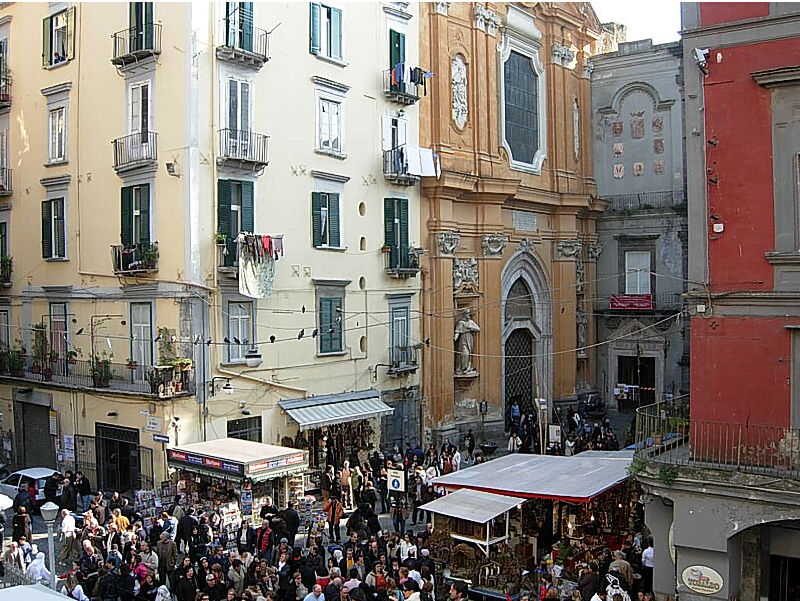You may not find this terribly rewarding unless you're included here, so this is a good time for casual and random browsers to turn back before they get too caught up in the sweep and majesty of the proceedings and can't let go.
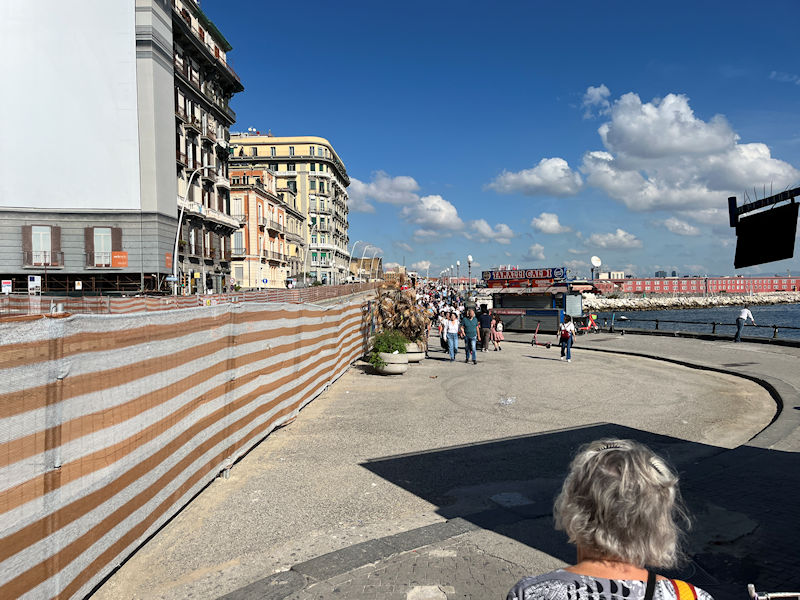
A fine day for a walk, first along the Santa Lucia waterfront, then . . .
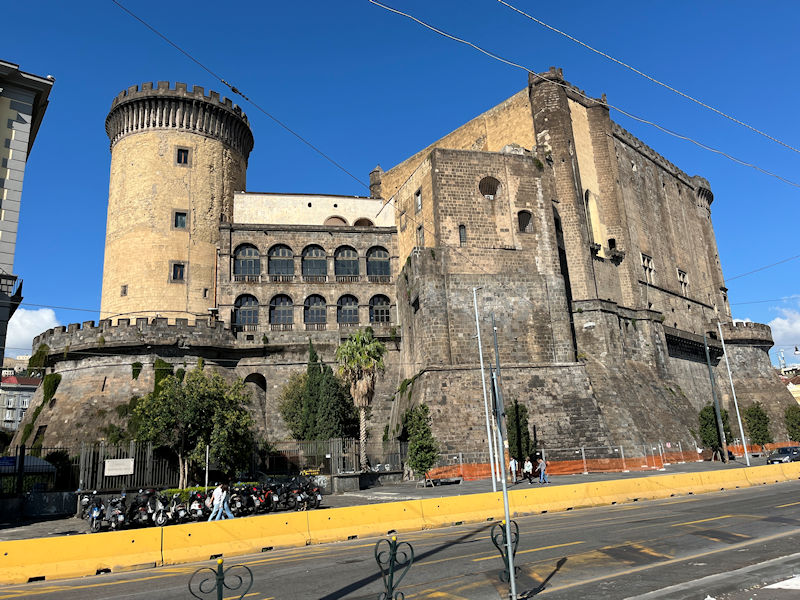
. . . down past the gardens Molosiglio facing the port, and round the Castel Nuovo, and then . . .
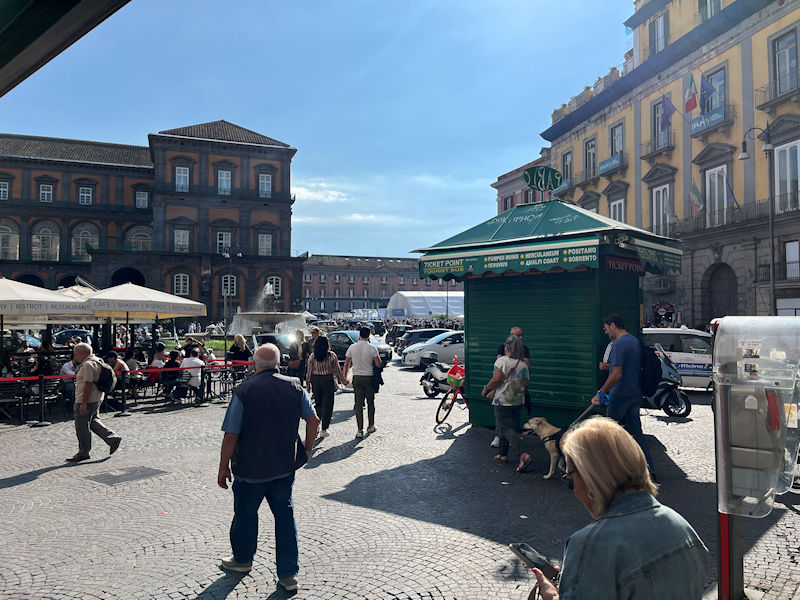
. . . back up, past the Teatro di San Carlo into the central Piazza Trieste e Trento, planning to turn up the . . .
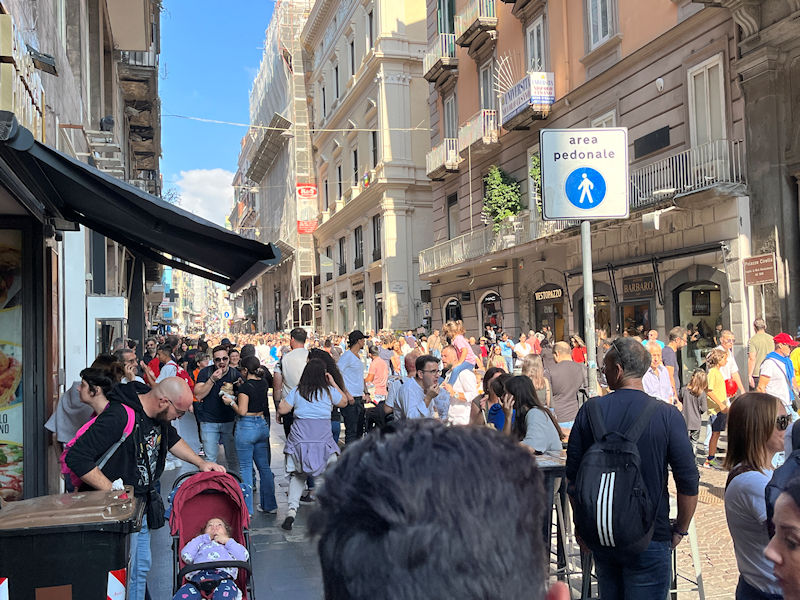
. . . Via Toledo shopping street. Yikes, forget it.
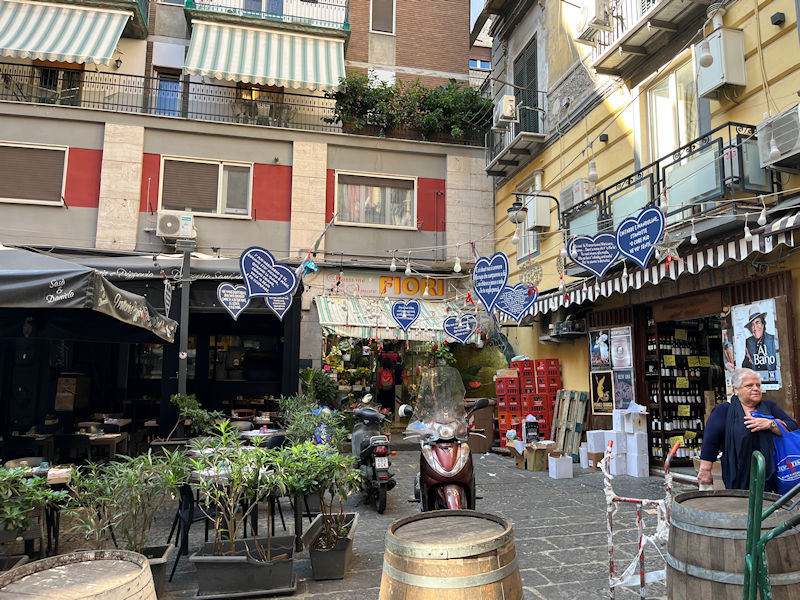
So instead we hustle up the Via Carlo de Cesare to the Piazzetta S Anna di Palazzo near the southern corner of the Quartieri Spagnoli.
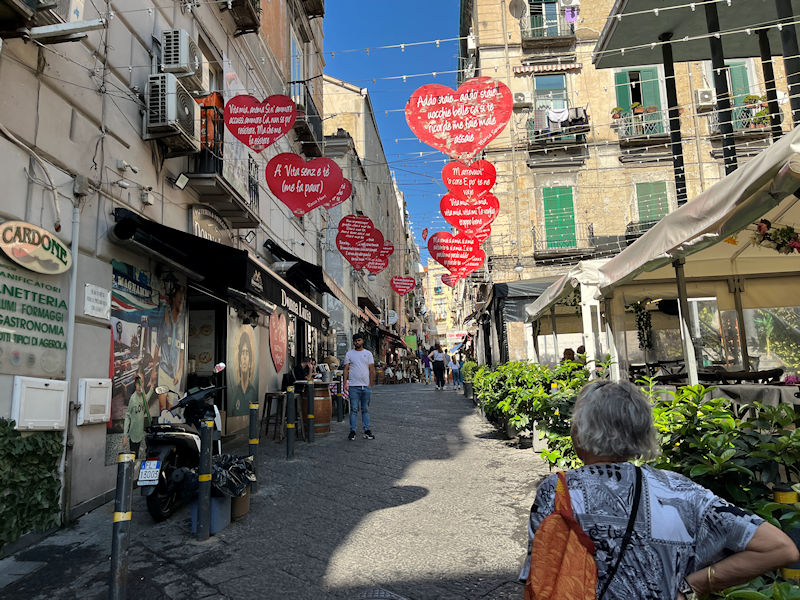
Turning north and wandering up the Vico Tiratoio. Kristin's probably been here often, but for my first venture to Naples we stayed in the Spanish Quarter in November 2010 -- we were warned that it's a horribly dangerous area, but neither then nor since have we found that to be so at all.
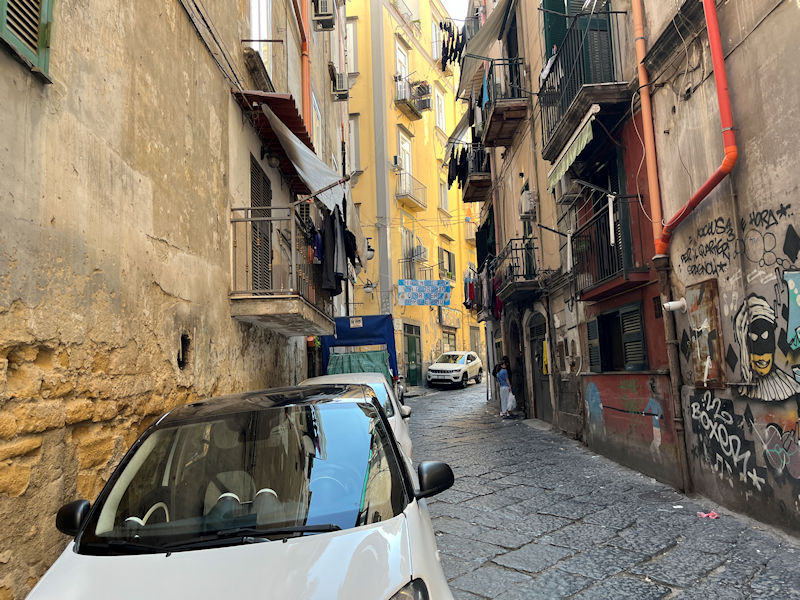
To recall, the present Spanish Quarter area was outside the city walls in the 16th century, as was the Via Toledo. In 1501, combined French and Aragonese forces occupied Naples and forced the last of the Trastámara Kings of Naples, Ferdinand II, to forfeit his claim. By 1504 Naples was to be ruled remotely by the Kings of Aragon for the next two centuries, and after a few ineffectual Viceroys (governors in the king's name), Pedro Álvarez de Toledo y Zúñiga (1484-1553) was named and served from 1532 to 1552.
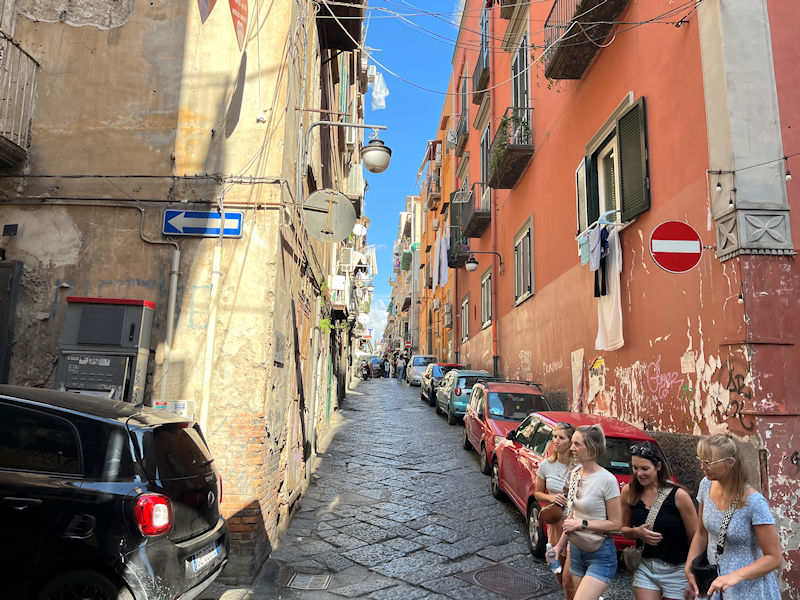
He was an extremely hard case in many ways, but he reformed Naples utterly, rebuilding the medieval city with a fortified sea wall along the port, modernized public buildings, a centralized administration (in the Castel Capuano), social and economic reforms, and apropos here: he widened what was renamed the Via Toledo and constructed this square grid of streets beyond it with multi-storied buildings (said to be the first in Europe) as a dozen blocks of barracks for his Spanish garrisons, the 'Spanish Quarter' of the city.
The Emperor Charles V, displeased with the Viceroy's efforts to initiate the Spanish Inquisition here, which had caused a rebellion of the local nobility, had him recalled in 1552, and he died in 1553 in Florence, where his daughter Eleanor was the wife of Cosimo I de' Medici, Duke of Florence.
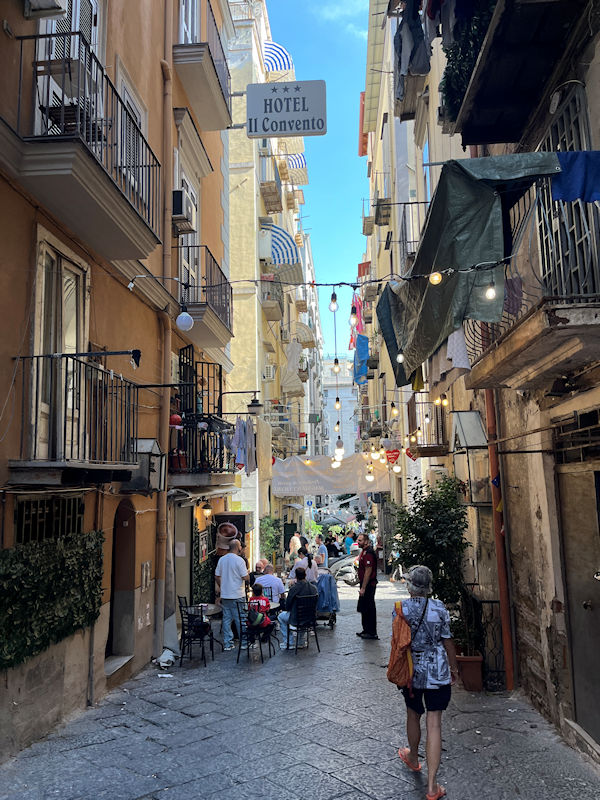
The Spanish Quarter, as a district, covers a bit over a kilometre backed from the Via Toledo to the foot of the serious slopes of the Vomero hill with its Castel Sant'Elmo watching down upon the populace, about 400m up the lower slope from the street.
We've been gawking about a little higher up and are descending the Vico Tre Re a Toledo, because this is our Nostalgia Moment -- the Hotel Il Convento, which really is a reformed convent, built in about 1600, was the pleasant site of our visit in 2010.
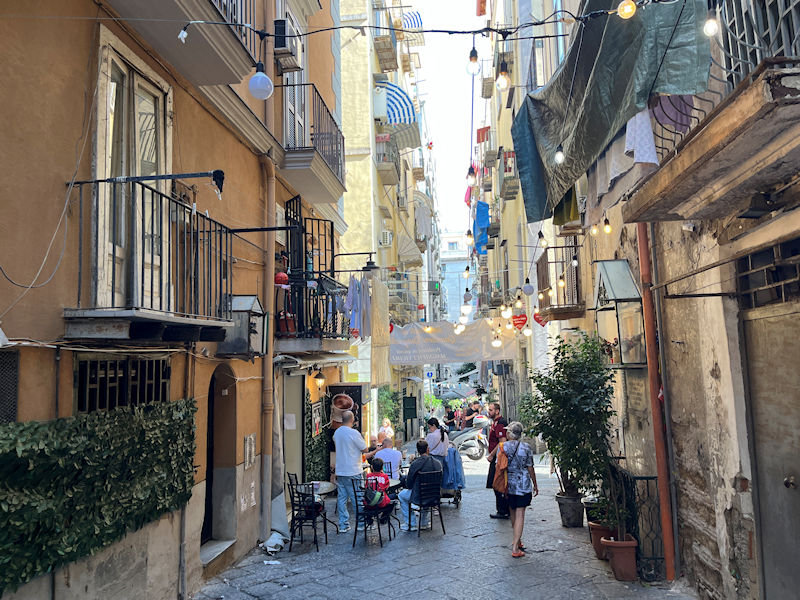
A caption from our 2010 visit: 'The neighborhood, in the Spanish Quarter, was originally the barracks area just outside the old town built for the Spanish garrison troops and their horses in the 16th century. Guidebooks and friends tell us that the Quartieri Spagnoli is too dangerous to stay in, but we found it unthreatening and congenial. One major problem, though: the Via Toledo is pedestrian, so the ubiquitous motor-scooters -- young men, young ladies, old ladies, whole families -- blast through the Via Speranzella at all hours, beeping their little buzzers like an act of religious faith as they zoop through each intersection, and pedestrian tourists need to stay alert.'
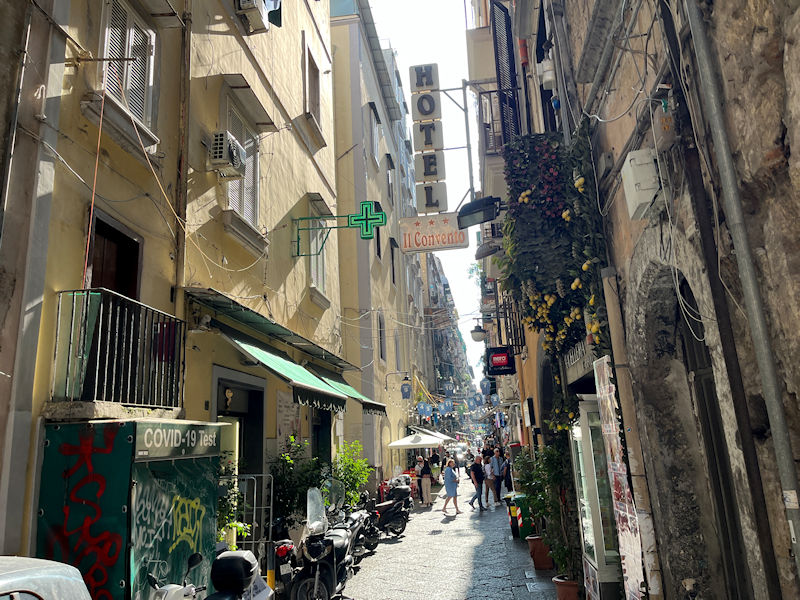
The hotel fronts onto the Via Speranzella, a mini-thoroughfare just two streets up from the Via Toledo. The last time we were here, Kristin stopped in to inform the present receptionist that we stayed here once before and loved it (but went elsewhere this time). 'He professed to be gratified.'
It may also be worth noting that in 2010 we dined nearly every night at the wonderful Hosteria Toledo, just two blocks farther along the Speranzella.
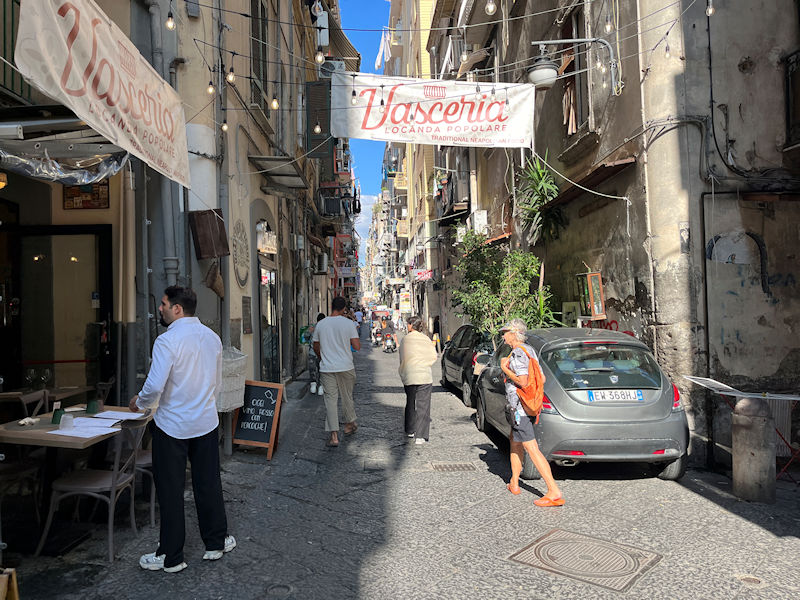
Northward on the Via Speranzella. These are not pedestrian roads back in here, as they are in some of the shopping districts (like much of Via Toledo), but it must be an special kind of hell to drive about here, worse still to find a parking space within a half-mile of your dinner awaiting you.
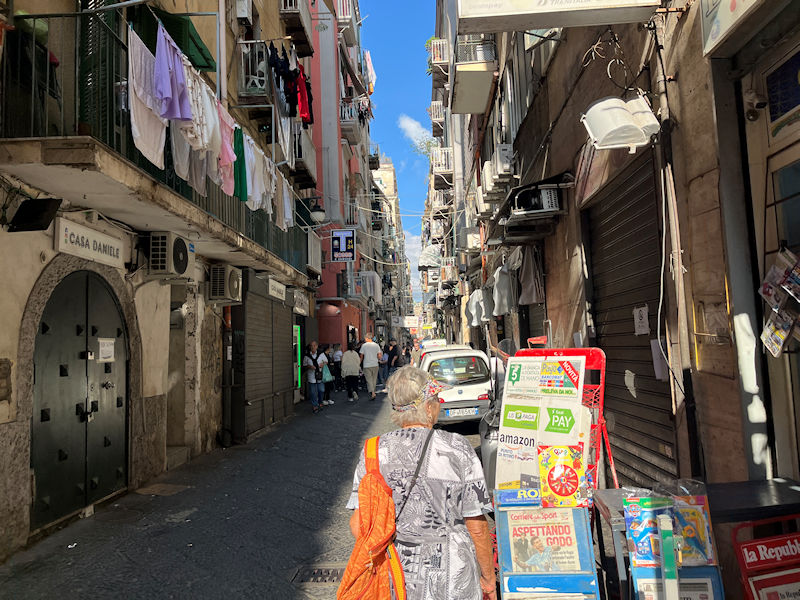
Now we're close to the east-west Via Emanuele de Deo, which is . . .
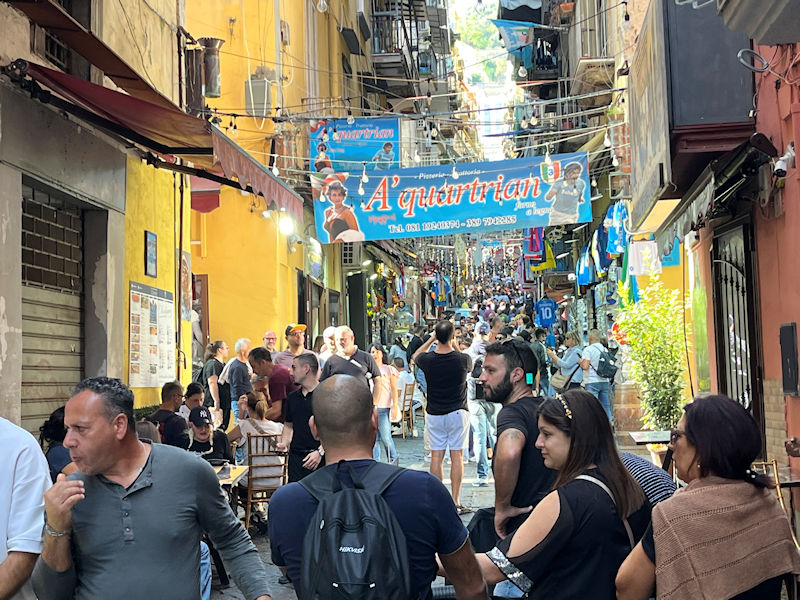
. . . alive with hordes of people progressing up the hill for some fixed purpose.
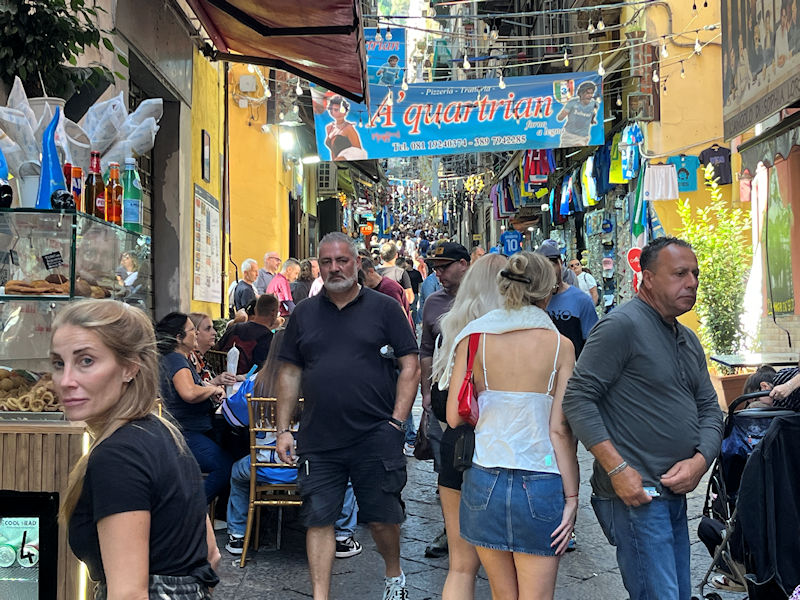
Possibly some religious occasion. On the other hand, some six or seven blocks up the Emanuele de Deo there is the Museum of Diego Maradona, along with a small piazza the walls of which are covered with pictures of Maradona and lots of Maradona merch.
Including a little statue of the 'Hand of God', Maradona's scoring goal for Argentina against England in the 1986 FIFA World Cup (out of national competitions he played for the Naples team).
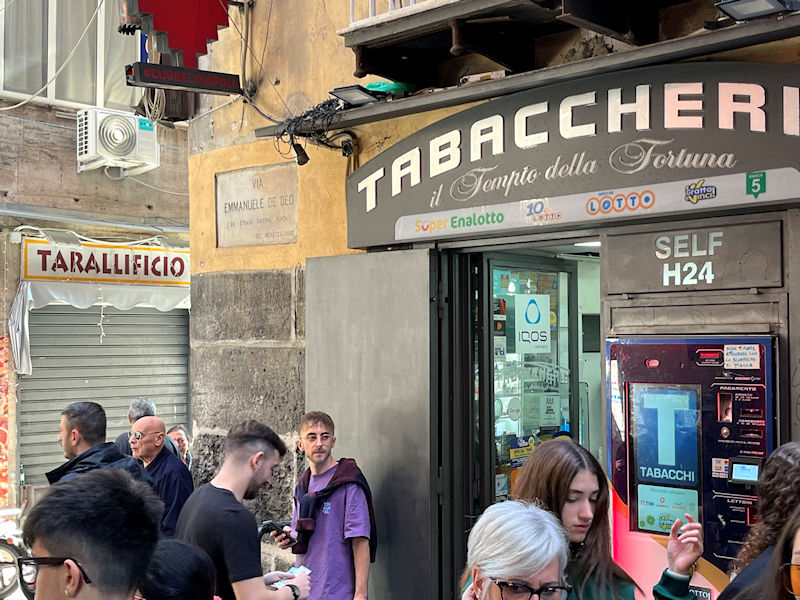
Notions of lunch begin to pass before our eyes. Every third storefront reveals an inviting looking trattoria. Not this tobacconist specializing in lottery tickets, though, called The Temple of Fortune.
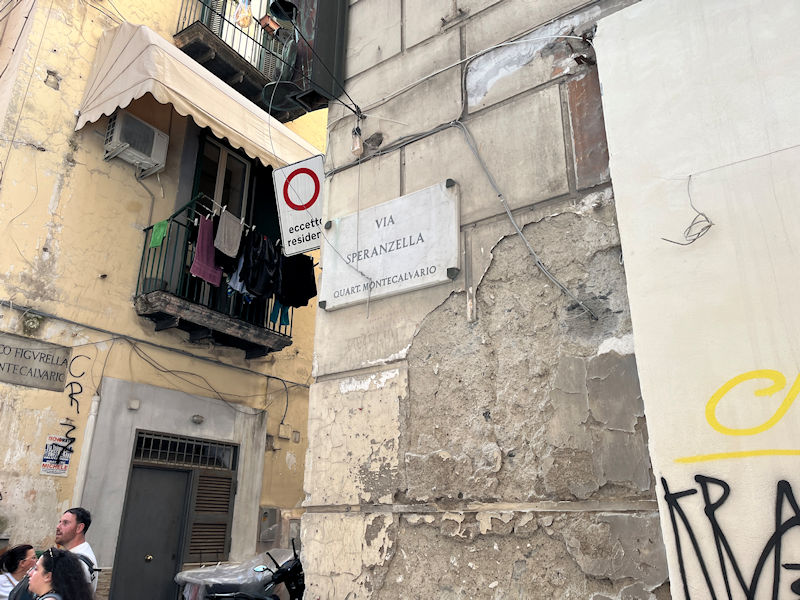
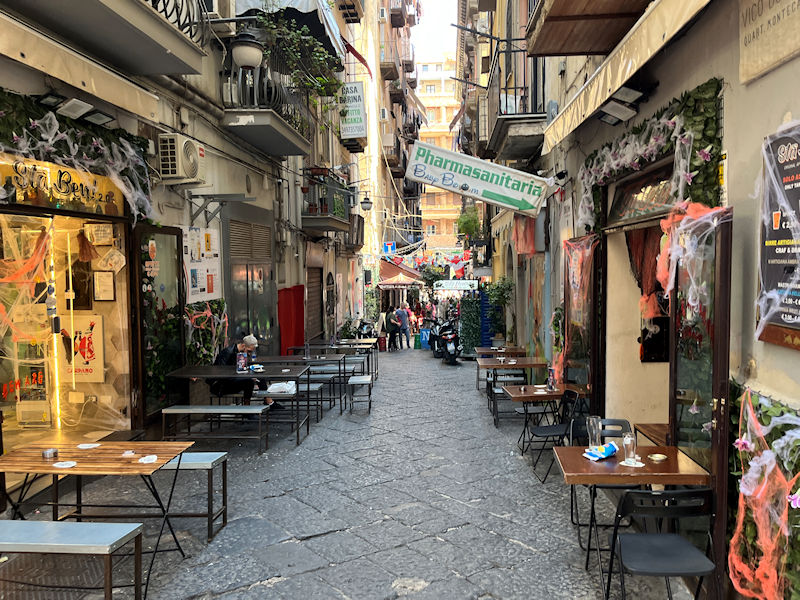
Somewhere round here we stopped off for a sidewalk lunch, maybe here . . .
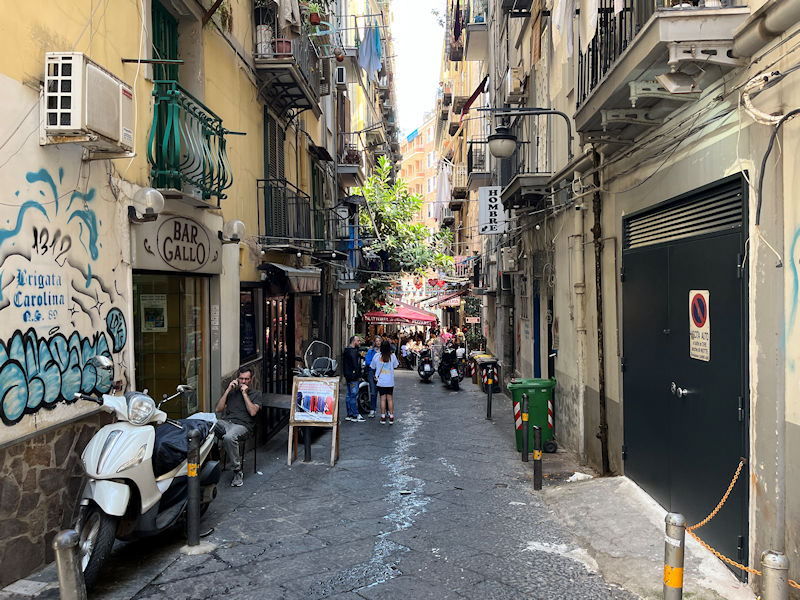
. . . or down there. Or somewhere else.
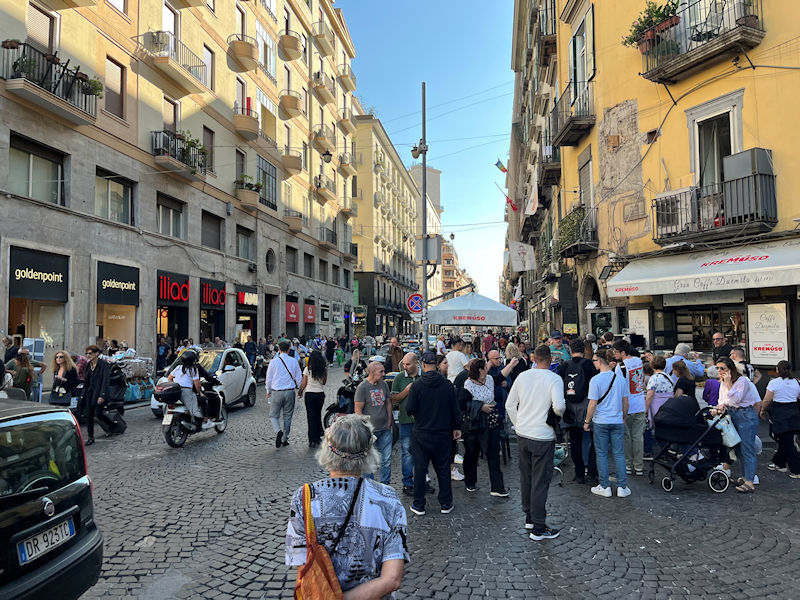
In any case, we emerged from the Spanish Quarter onto Via Toledo near the KFC on the Piazza Carità, and are now, after a nice lunch, lurching southward back down towards the port.
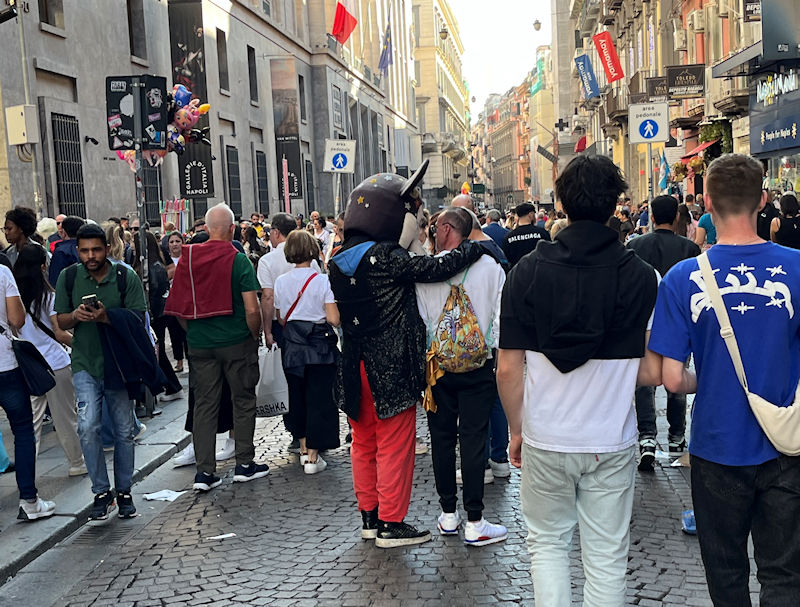
Obviously, we never asked any questions here, just moved to the other side of the street.
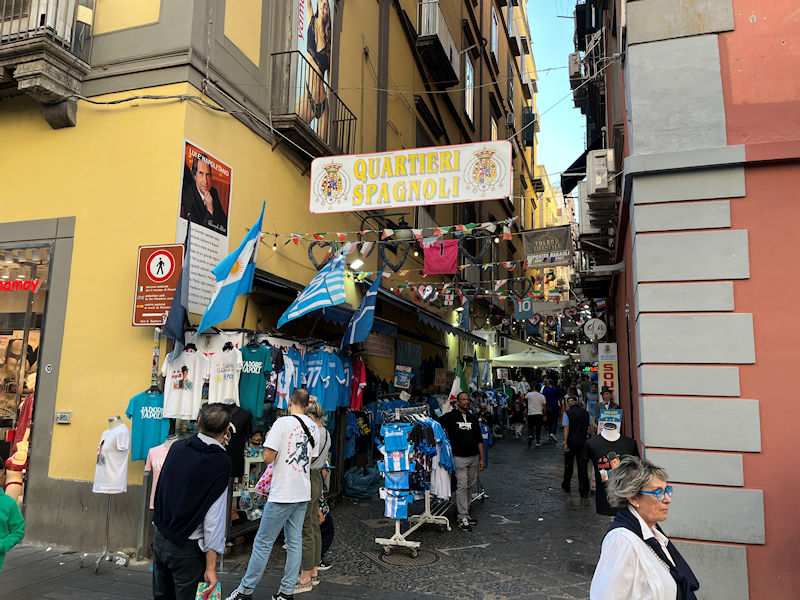
We have fond memories of the Spanish Quarter.
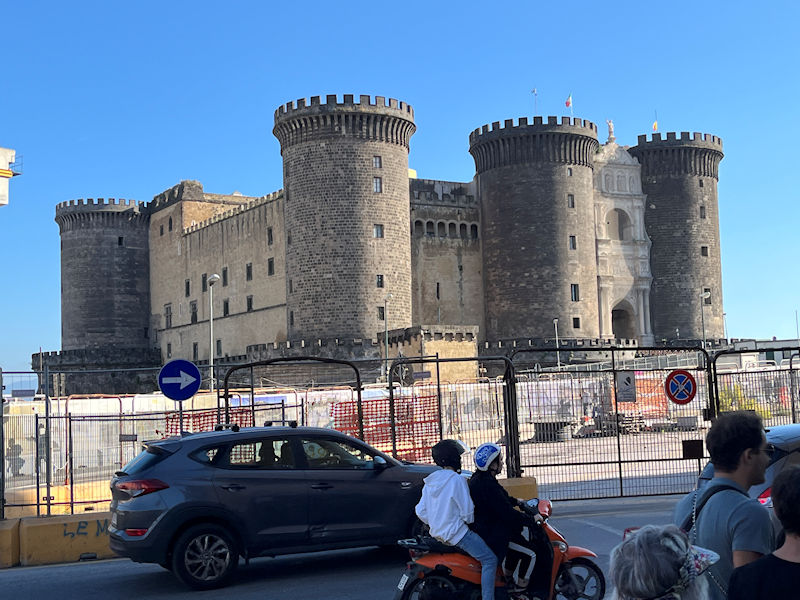
After some quiet back streets round by the city hall and Piazza Municipio, we're strolling back past the Castel Nuovo to learn what all the excitement was about, a few days ago, in the . . .
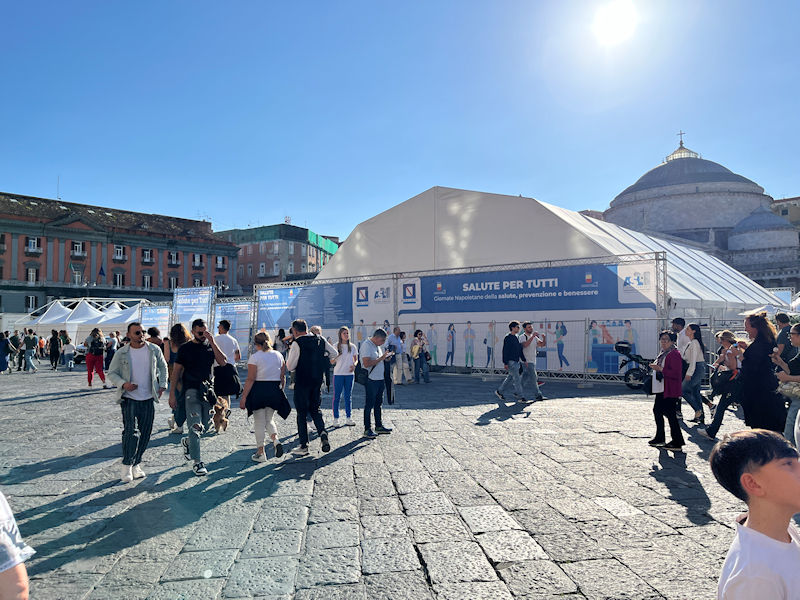
. . . Piazza del Plebiscito. Turns out it was a civic extravanza in aid of the public health . . .
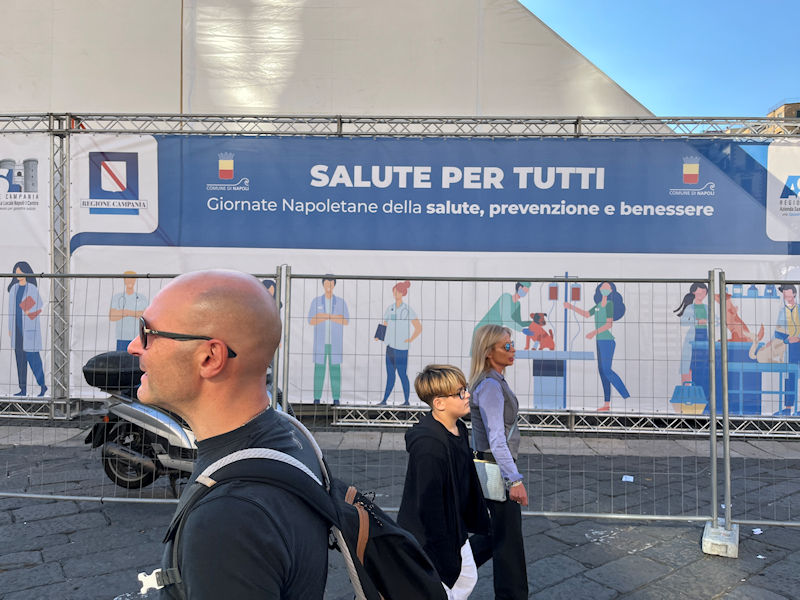
. . . 'Neapolitan days of health, prevention and well-being', with . . .
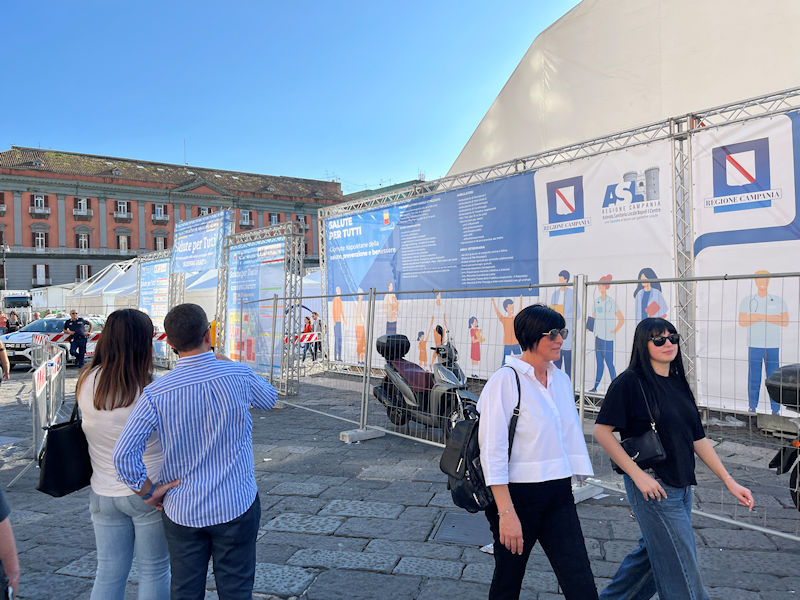
. . . many government and non-governmental organizations set up for educational and free-testing purposes. All taken down and bundled out the next day.
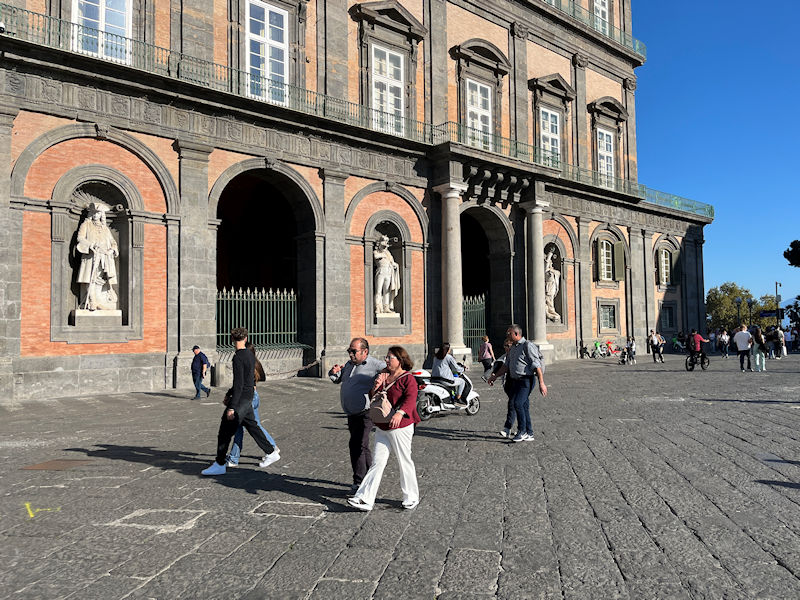
The Palazzo Real as we're returning to our roost.
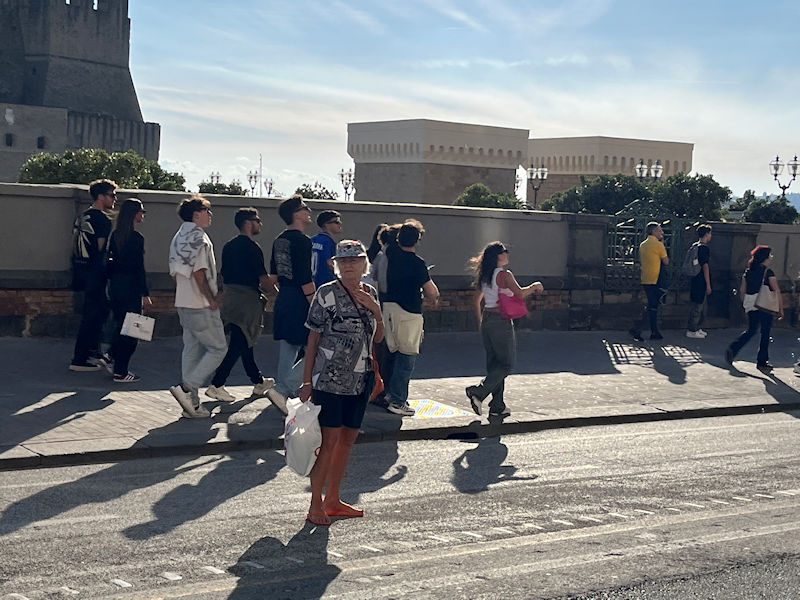
Back to the Castel dell'Ovo and . . .
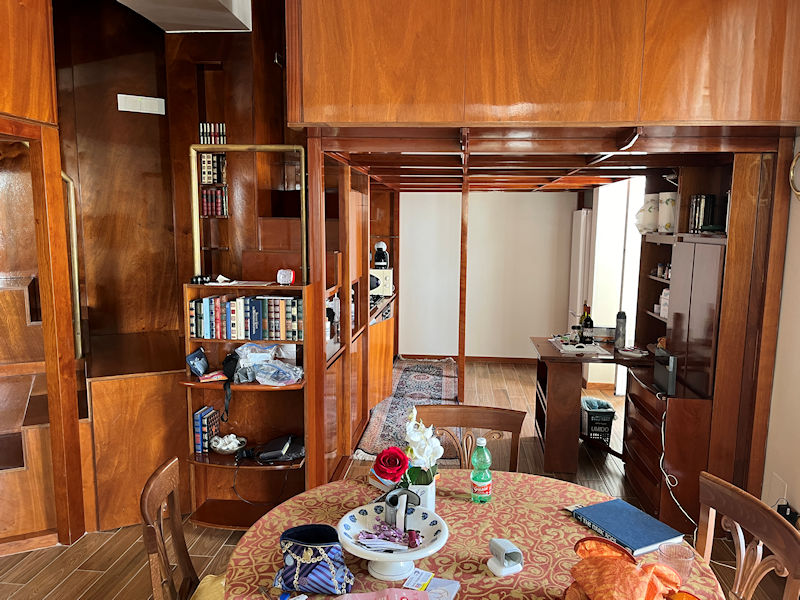
. . . a little rest-up before dinner, as . . .
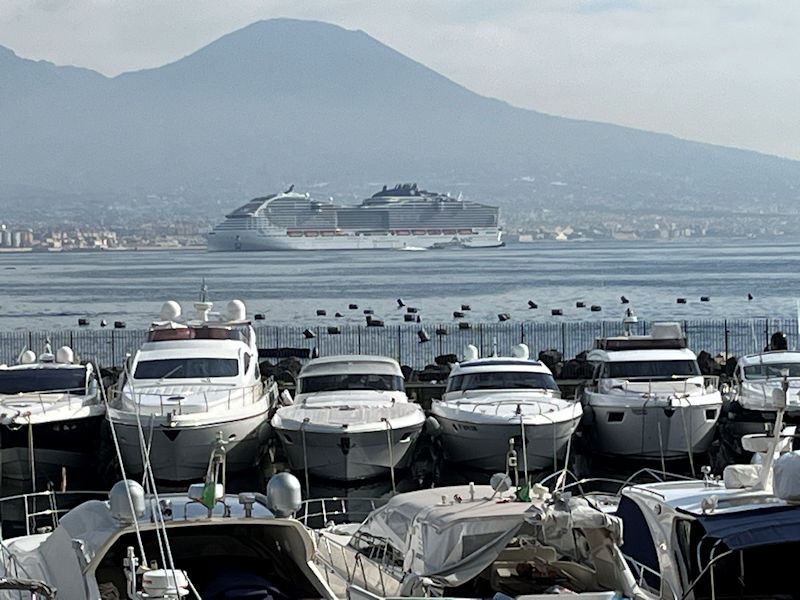
. . . gargantuan cruise ships parade into port. Or out of it, it's hard to tell. Dinner at Anticho Sapori on the Via Santa Lucia, very good.
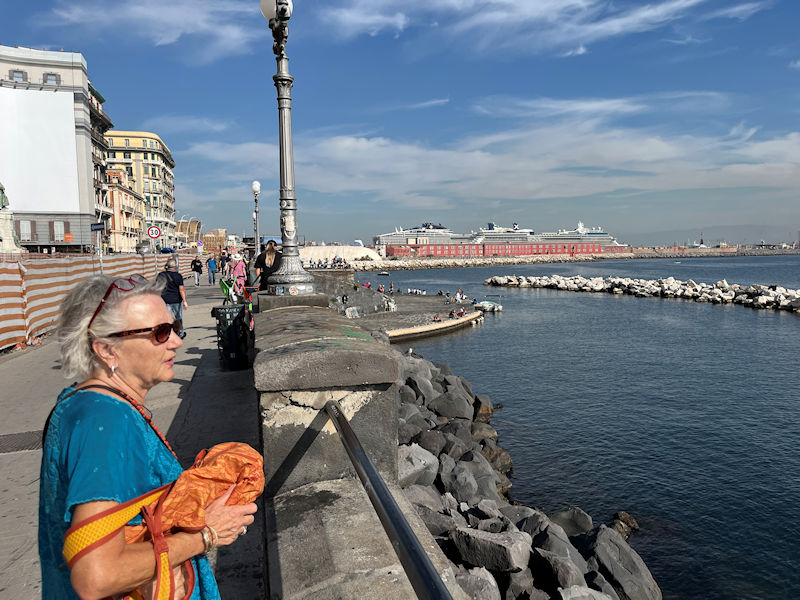
The next day we've decided to hop on a 'Hop On, Hop Off' tourist bus, which is based near the Castel Nuovo and offering two routes, one a loop up round the central city where there are streets more or less able to accommodate buses, and the other up into the neighborhoods above where we were walking the other day on the way to Averno.
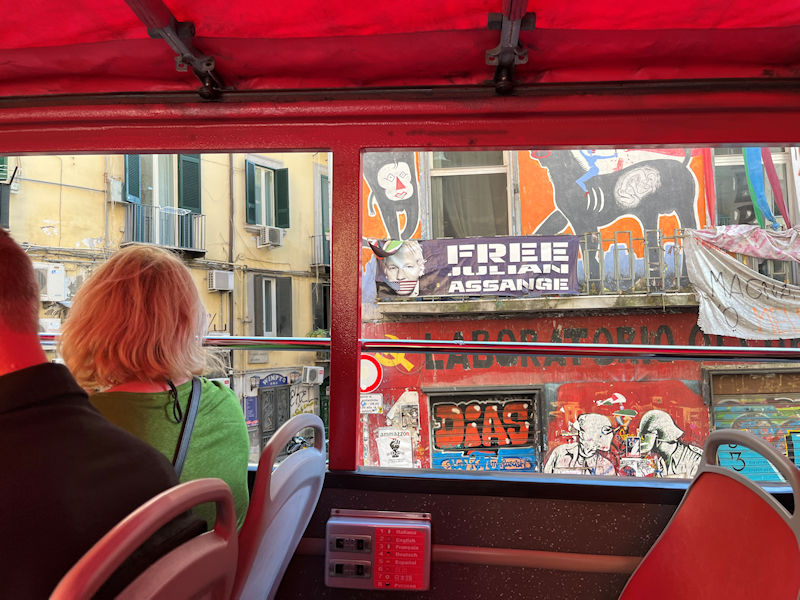
The first one had very little interest, especially for someone with a camera -- there was this eloquent message just down the hill from the Chiesa del Gesù Nuovo, and there was . . .
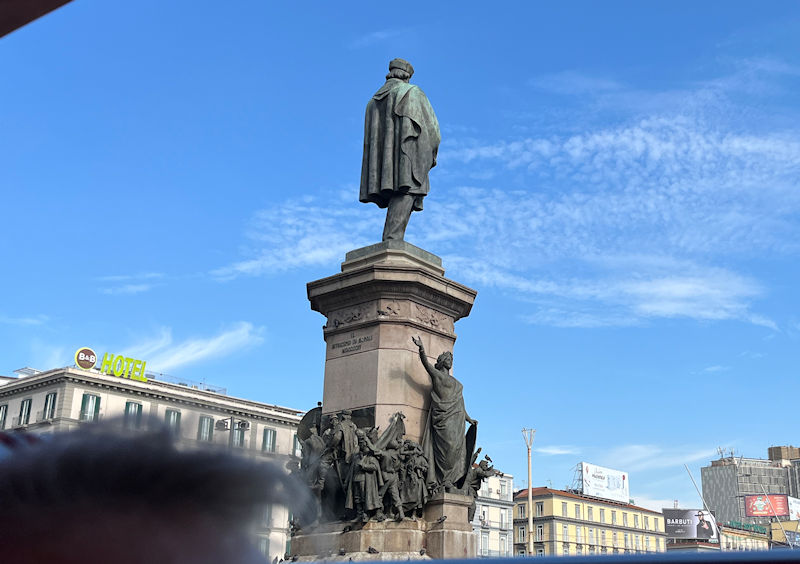
. . . this statue of Giuseppe Garibaldi at the head of the 350m Piazza Garibaldi facing the Napoli Centrale rail station on the far side of town. Any statue of Garibaldi statue is worth seeing, even passing by from the back, but the rest of the tour was useless. The second tour struck us, certainly from a photographic point of view, as entirely useless.
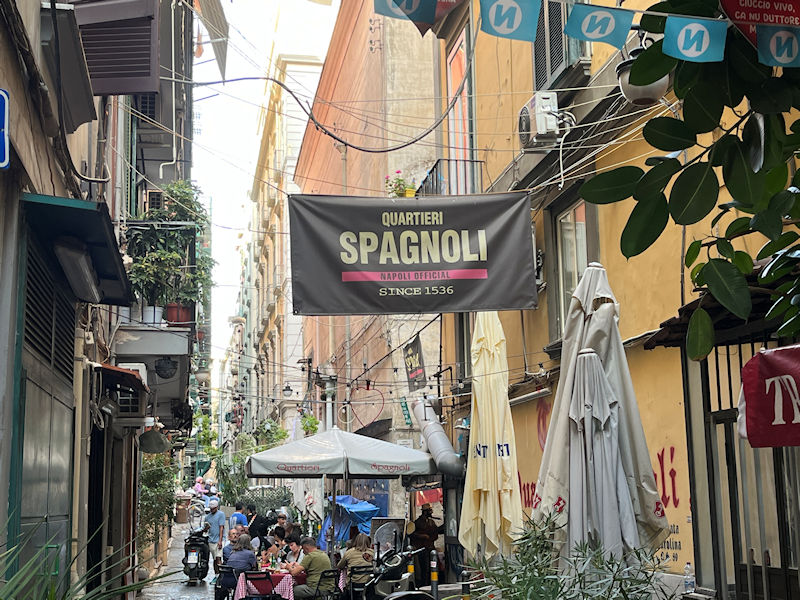
But that's okay, there's plenty else to occupy our time.
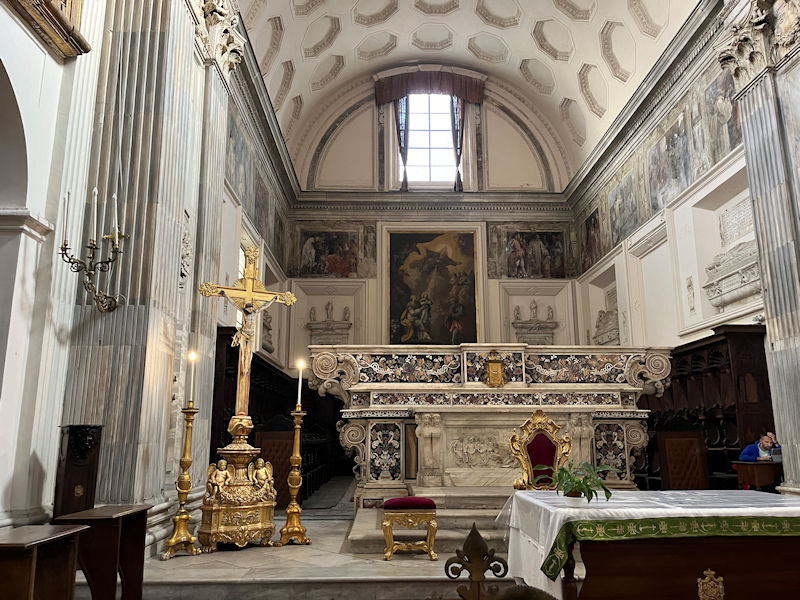
Like, just above the Piazza della Carità, a peek into the Complesso Monumentale Sant'Anna dei Lombardi ('Renaissance artwork in a graceful church'), always worth a quick stop.
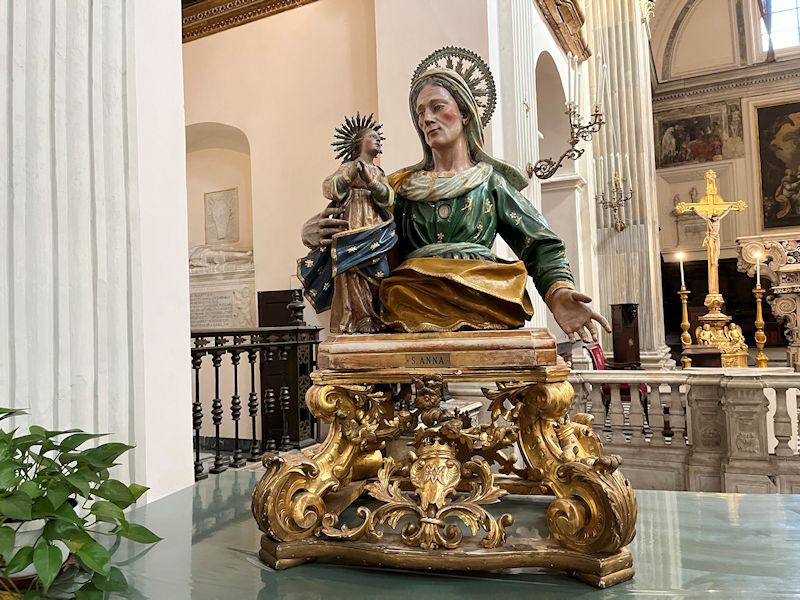
That's Anna of the Lombards there -- always good with kids, especially those with their own haloes on.
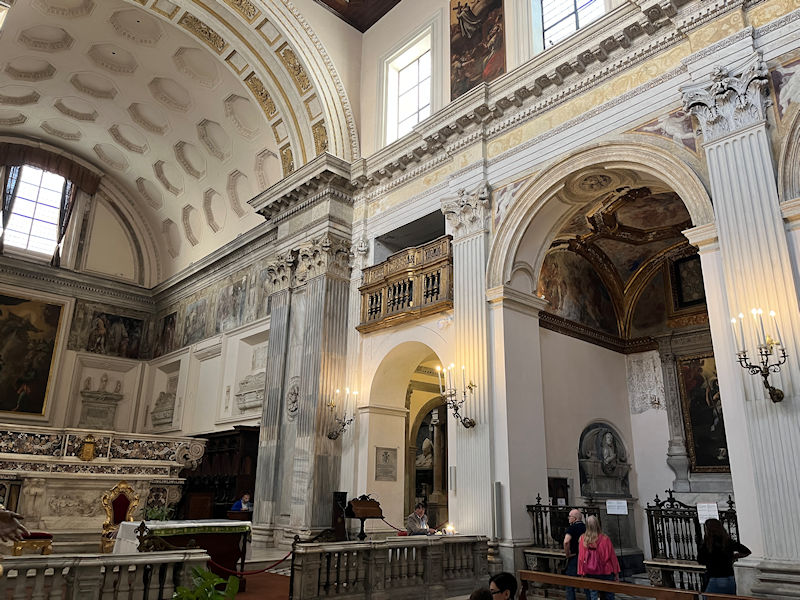
We can't linger, but we viewed a good deal more of the good stuff last year: here.
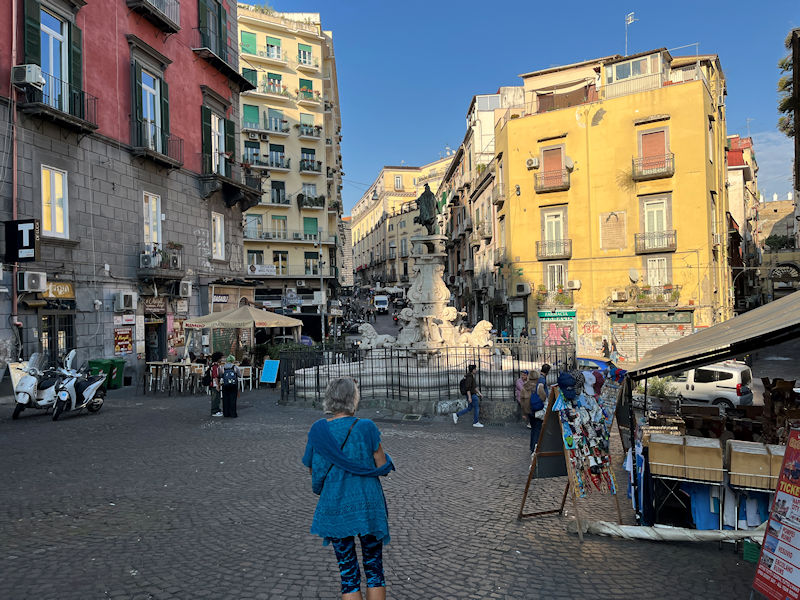
At the bottom of the Piazza Monteoliveto, that's the semi-undistinguished statue of Carlo II (1661-1700), the last Bourbon King of Spain; a forgettable statue for a forgettable king, yeah?
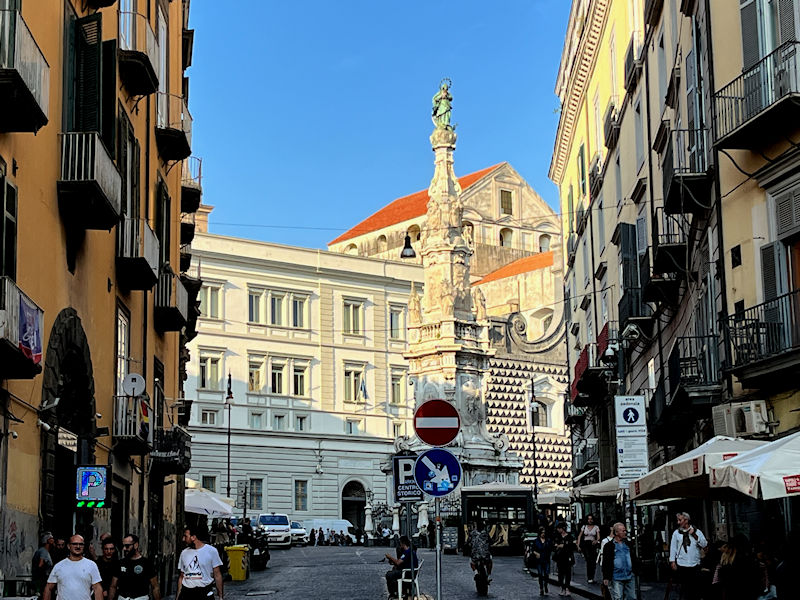
Walking up through the Piazza del Gesù Nuovo, on our way to . . .
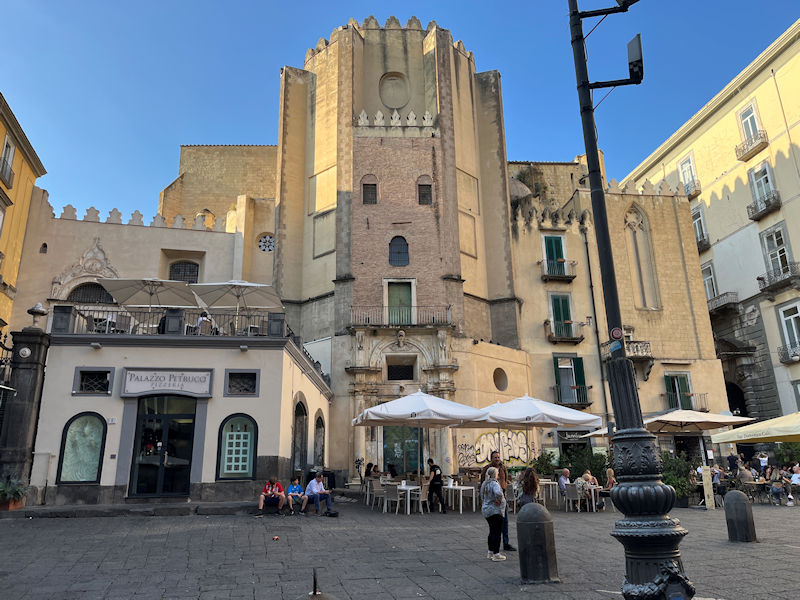
. . . the rear end of the Chiesa di San Domenico Maggiore and related piazza. We need to book a later visit to the Museo Cappella Sansevero ('Funerary chapel with renowned sculptures'), just a block up the street on the right. That done . . .
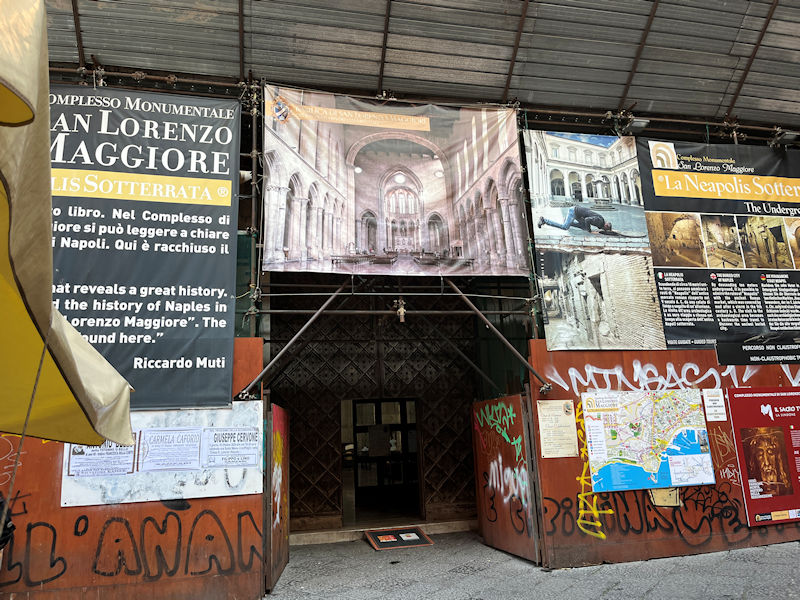
. . . we stop over at the San Lorenzo Maggiore, with more time to spend here than we had the other day.
We can't describe the well-regarded façade, as it's said to have been covered with scaffolding for quite a few years. A photo nicked from Wikimedia Commons is included at the end of this page.
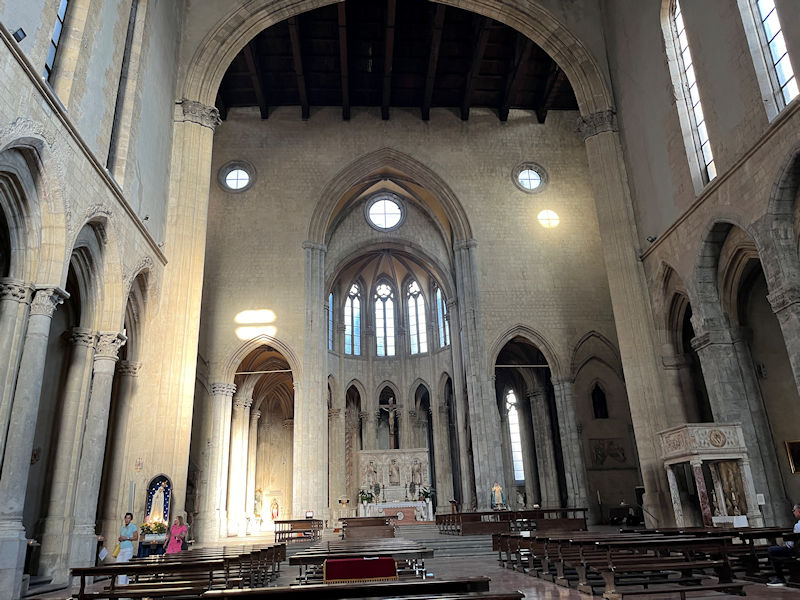
The new ruler of Naples and the south, Charles I of Anjou, commissioned this church in 1270 for the Franciscan Order, apparently in compensation for having taken over their church for the construction of his new fortress. It's on the site of a 6th century Christian church which was itself built on the forum and marketplaces of the ancient city (much of which has been and is being excavated and open to the public since 1992).
[We're importing a few of the researched captions from last year's visit.]
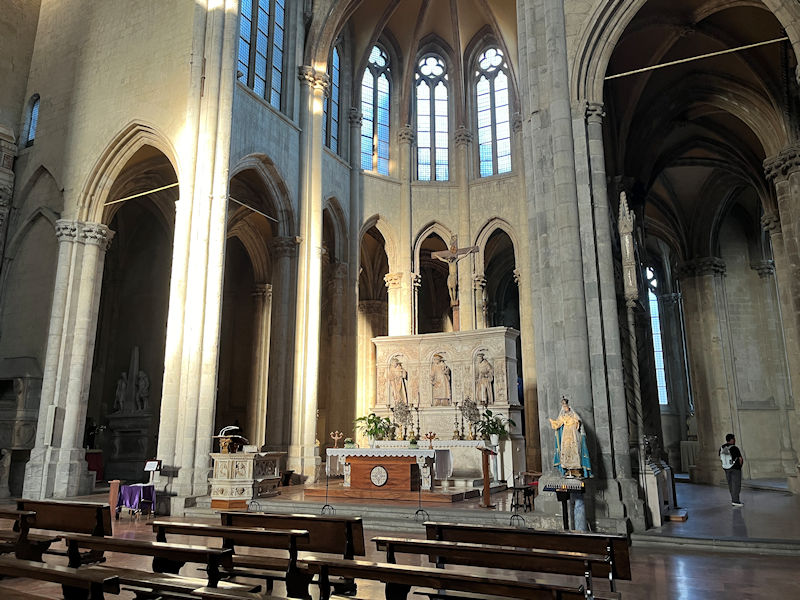
The main altar. King Charles, being French, brought along his own architects and craftsmen in his entourage, and beginning with the east end, they employed the traditions of the northern French Gothic style. As the work progressed into the next century, the Italian workers began to shift over to what it is now called the Gotico Angioiano, i.e. French-style Gothic mixed with Italian traditions. Thus, this church 'consists of choir and ambulatory with ribbed vaults in 'Parisian' Gothic style, and transept and nave with pointed arches but open sight into the woodwork of the roof, as it is frequent in Italian architecture' (Wikipedia sub 'Gotico Angioiano').
In modern restorations, the interior of the church has been stripped of its Baroque embellishments in favor of this more original simplicity.
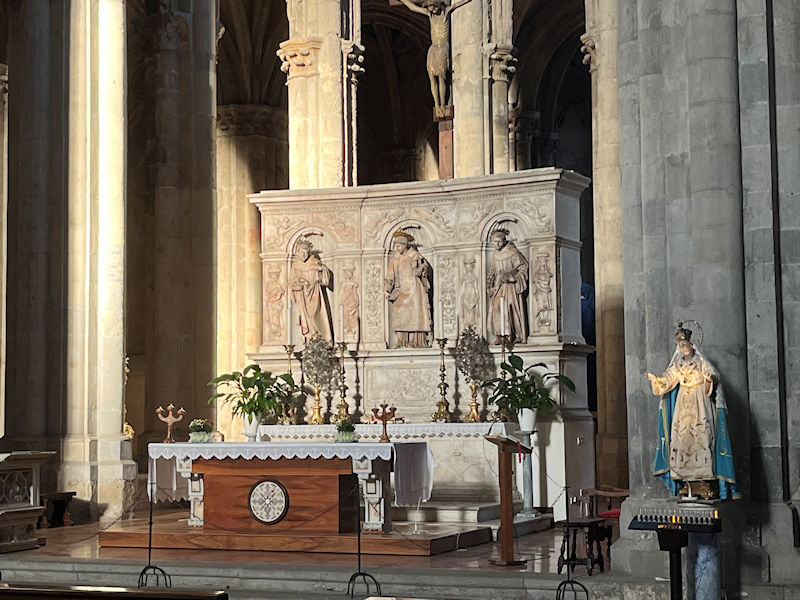
The main altar, by Giovanni da Nola in c.1530, features statues of St Lorenzo (Lawrence), St Francis of Assisi, and St Anthony of Padua. Beneath them, invisible from here, are appropriate representations for each: Lorenzo's martyrdom on the gridiron, Francis taming the fierce wolf of Gubbio, and Anthony preaching to the gathered fish in Rimini.
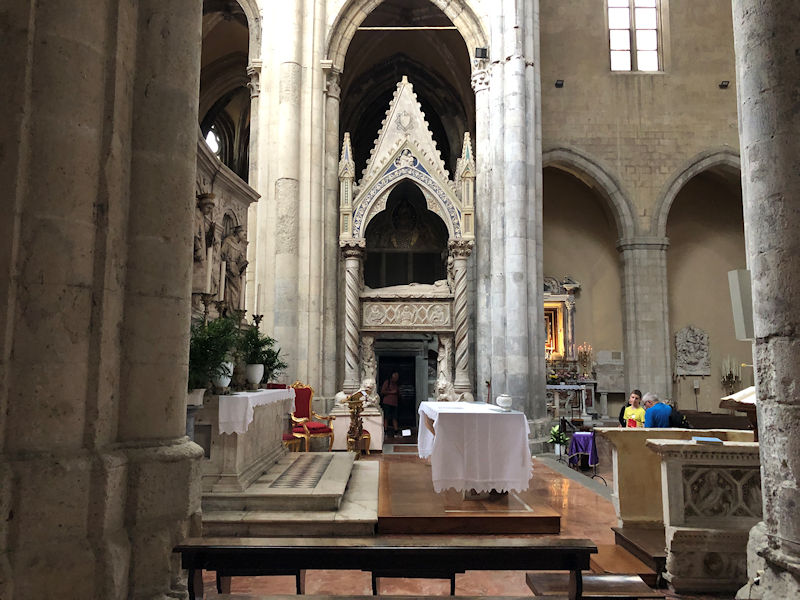
The funeral monument of Catherine of Austria, daughter of Albert I Habsburg, who was King of Germany from 1298 to 1308. She was married to Charles, Duke of Calabria, at age 21 in 1316, but died in Naples without issue in 1323. This was made by Tino da Camaino in 1324.
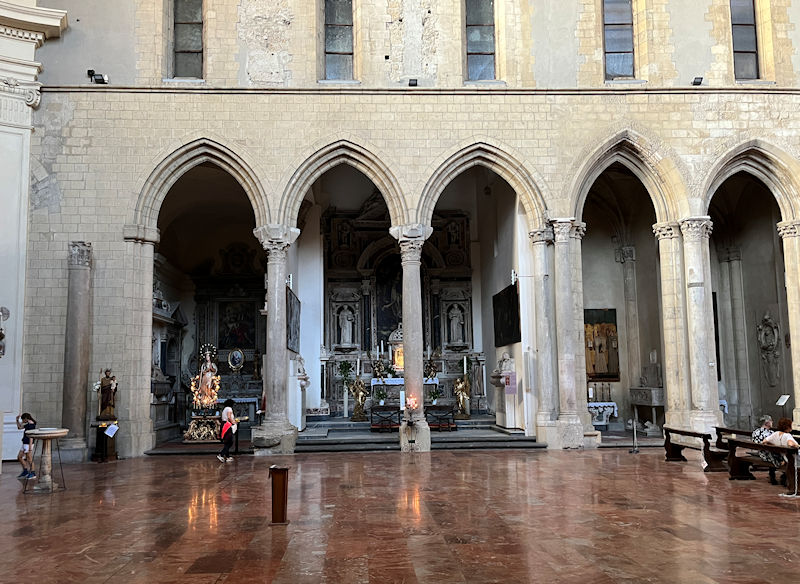
There are no aisles, but 23 side chapels face directly onto the nave.
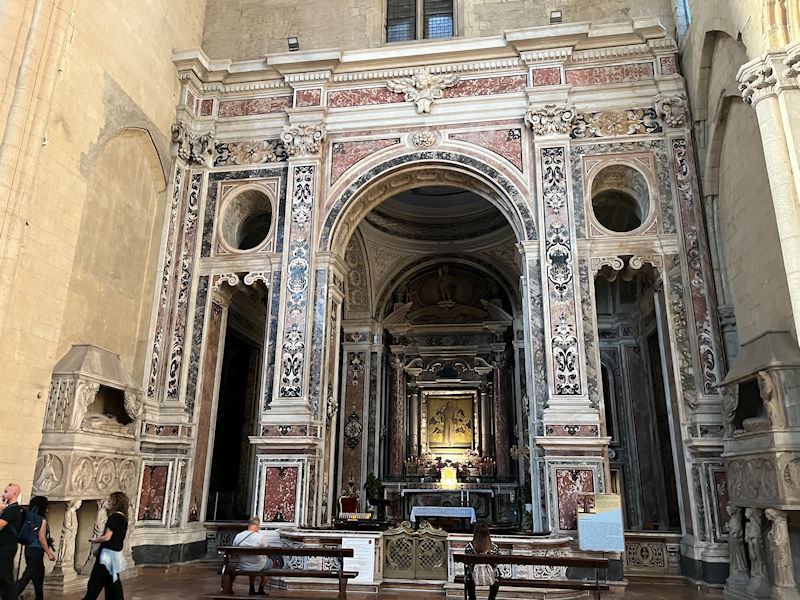
This is the ornate Cappellone of Saint Anthony of Padua in the back wall of the left transept, a baroque work by Cosimo Fanzago in 1638.

St Anthony with the six angels (which from here look like crows) refers to a miracle that is said to have taken place in 1623 in which an innocent young man was condemned to death with no redress; his wife, however, left a petition overnight on the high altar in the chapel and the next morning the viceroy set him free; it was believed that St Antony had come on down to plead the case directly.
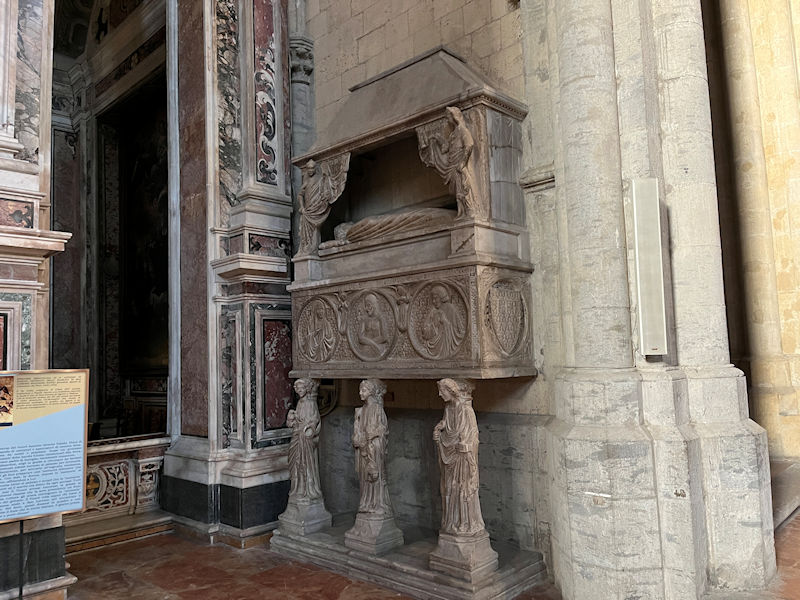
The sepulchre of Robert IV of Artois, Count of Eu, and Joanna (Giovanna) Duchess of Durazzo, who married in about 1376 and were at the Castel dell'Ovo when they were poisoned in July 1387 on orders of Joanna's younger sister Margaret, who was then the queen dowager and regent of Naples as guardian for her minor son Ladislaus. The sepulchre dates from 1399.
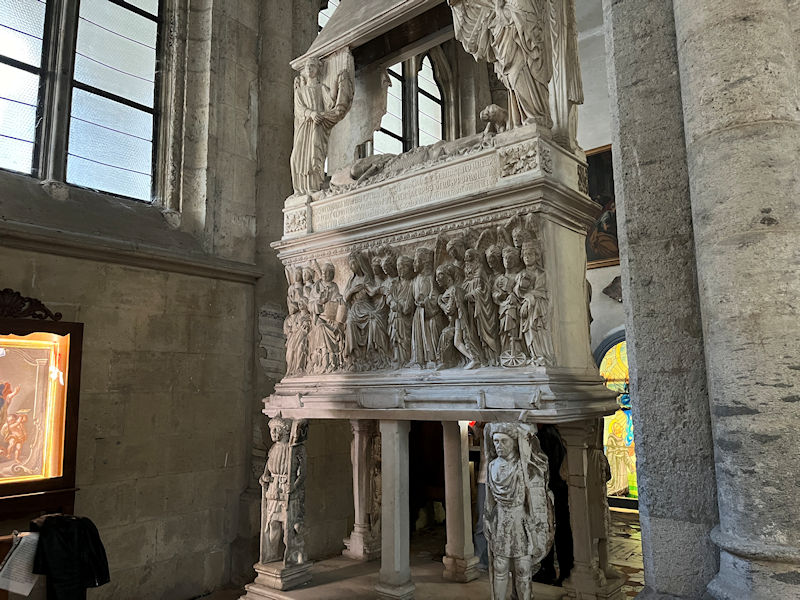
This is the tomb of Ludovico Aldomorisco, a Neapolitan admiral and advisor to King Ladislaus of Naples (r. 1386-1414), sculpted by Antonio Baboccio da Piperno in c. 1421.
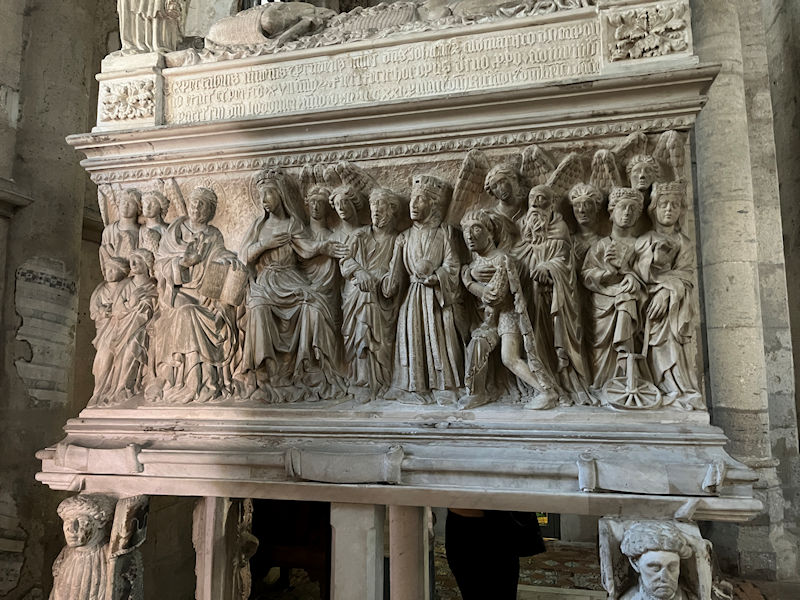
The reliefs show Ludovico being introduced to the Virgin Mary, then to Christ, then (with the crown on) to King Ladislaus, who had died at 37 in 1414, to be succeeded by his sister Joanna II (d. 1435).
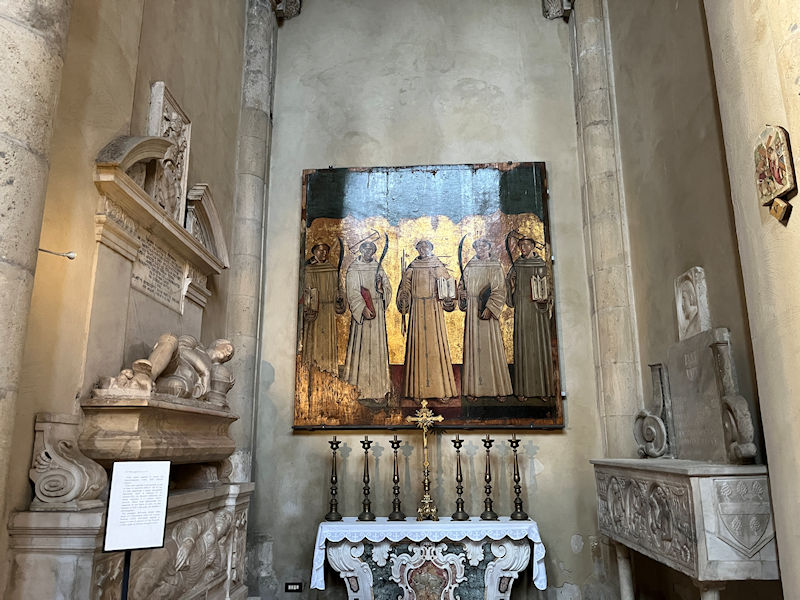
This is the Cappella Pignone. Of the 23 side chapels, this is one of the barest, but (in addition to the tombs) it's focused on . . .
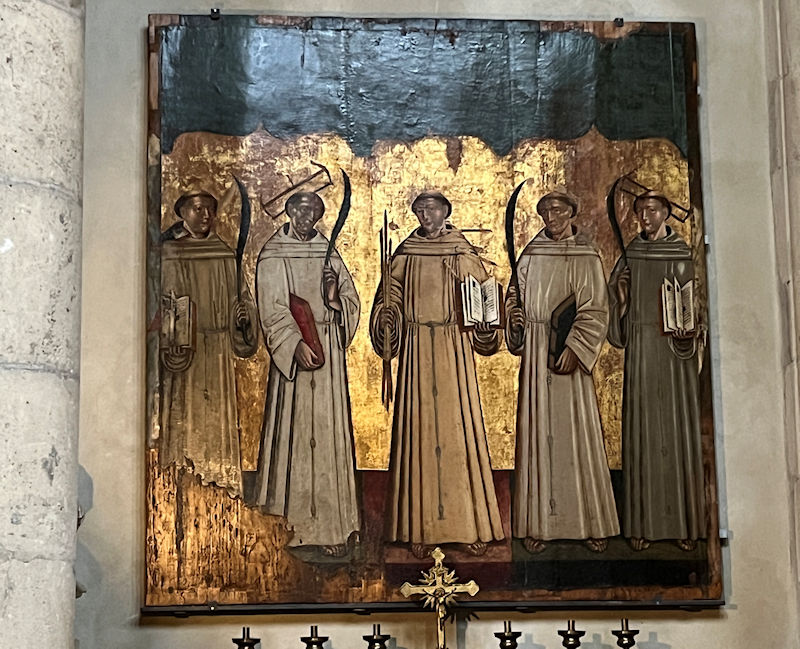
. . . this panel painting by the Neapolitan painter Angiolillo Arcuccio (died c.1492) showing five Franciscan missionaries who were martyred in Morocco in 1220 (during St Francis' lifetime). The artist adds saws, arrows, and rocks to show the manner in which each of them was martyred.
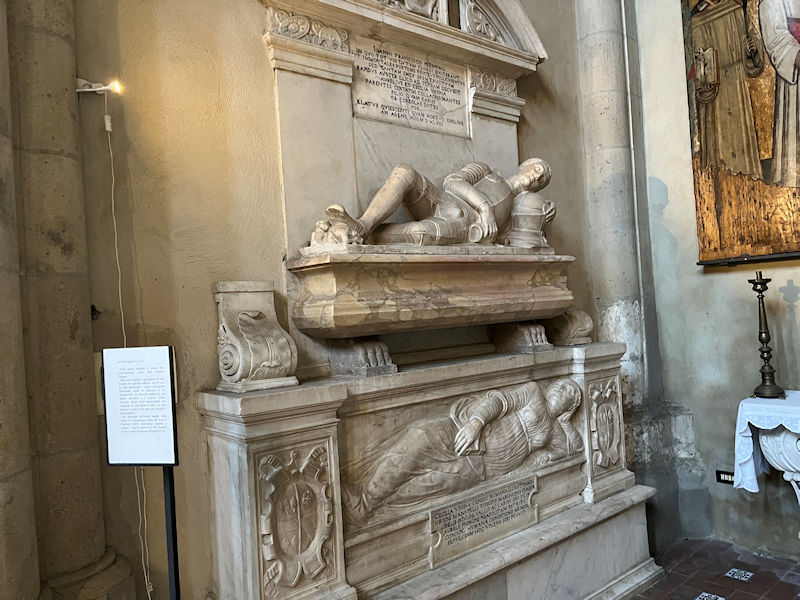
The inscription above the sarcophagi mentions members of the 'Pignono' family and carries the date 1548.

That's the tomb of Mary of Durazzo, daughter of Charles of Durazzo, King of Naples from 1382 (when he had Queen Joanna I assassinated) to 1385. The little girl was only 2 or 3 when she died in 1371, and here on the front she's accompanied by two angels.
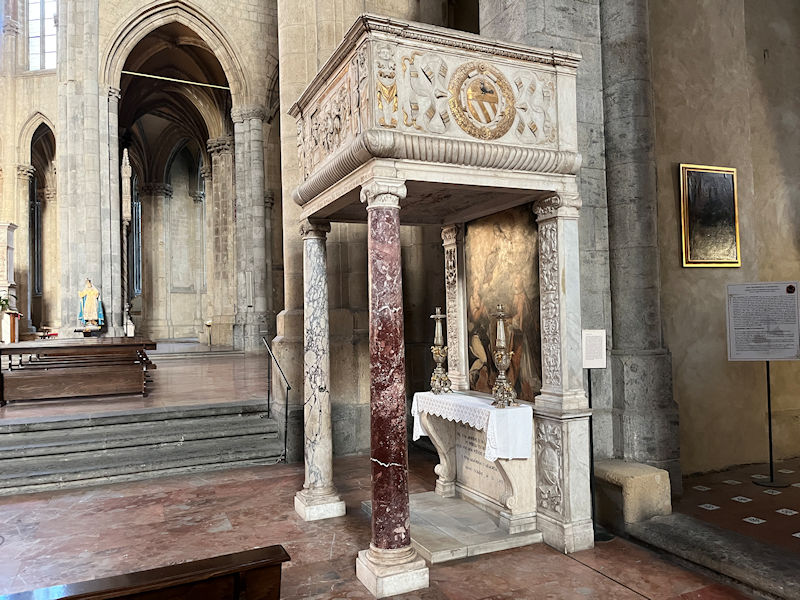
This is the 16th century pulpit or ambo, with a picture of St Catherine of Alexandria in front of the tyrant Maxentius.
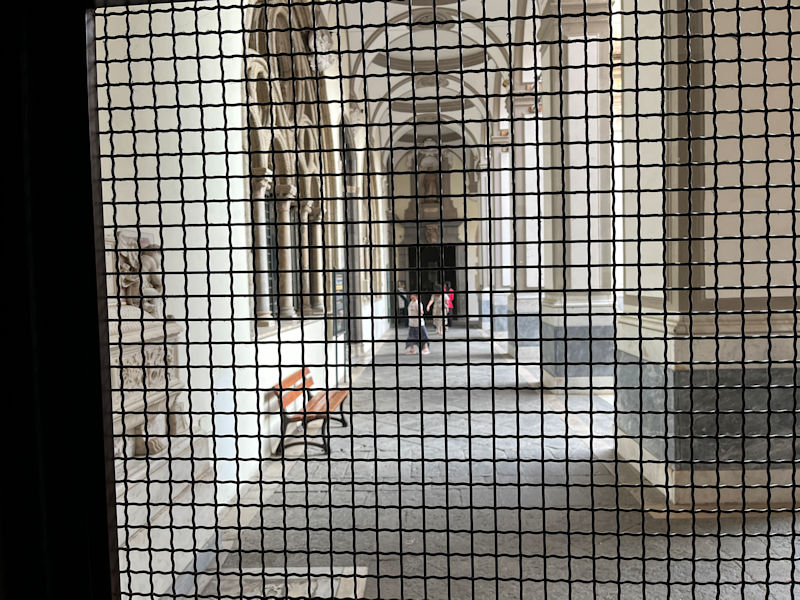
The passage to the convent and cloister
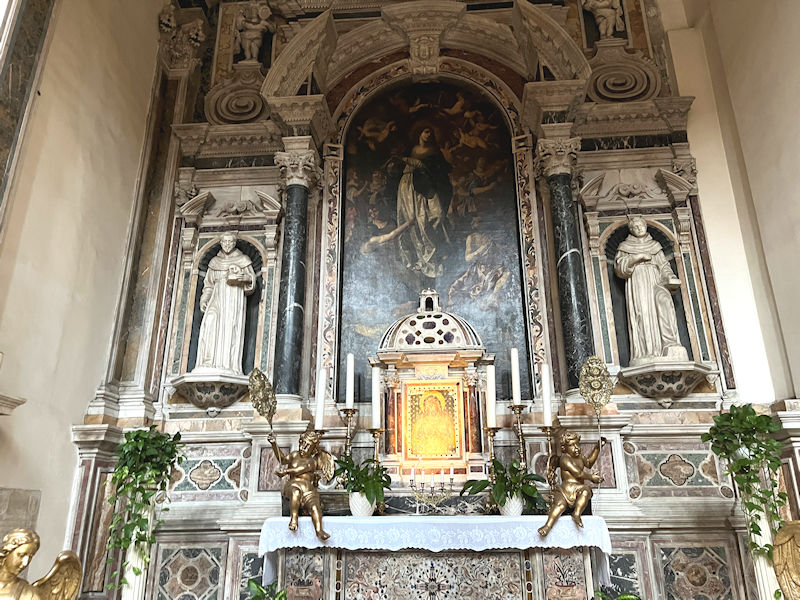
A side chapel with the notation 'Preghiera dell'Ecce Homo'

This is the tomb of the Cicinello family, with Carlo Tucci Cicinielli and his son of the same name snoozing atop it.

A fine relief of the Madonna, Child and Angels, once part of the main altar, made by Giovanni da Nola in about 1530.
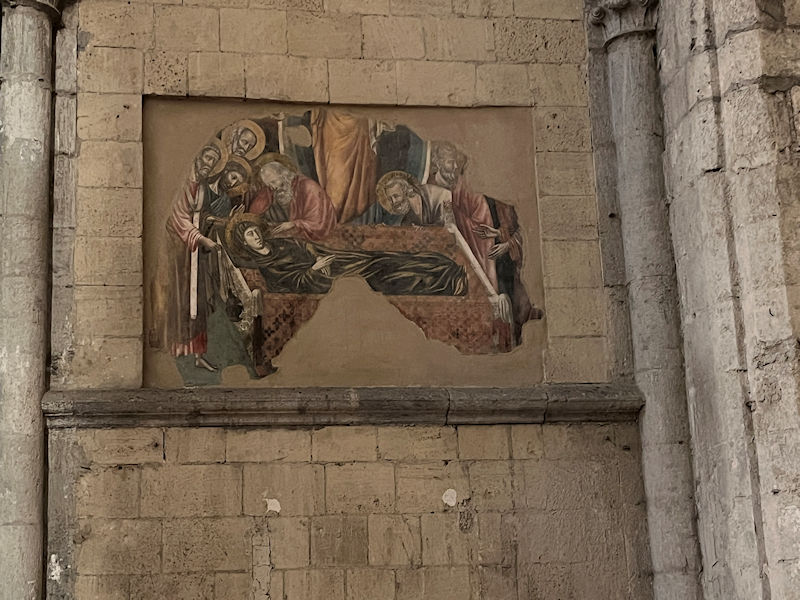
That is the Dormition of Mary (Dormitio Virginis) by the Giotto-esque Tuscan artist Montano d’Arezzo, from about 1300. One of the very few early frescoes surviving here.
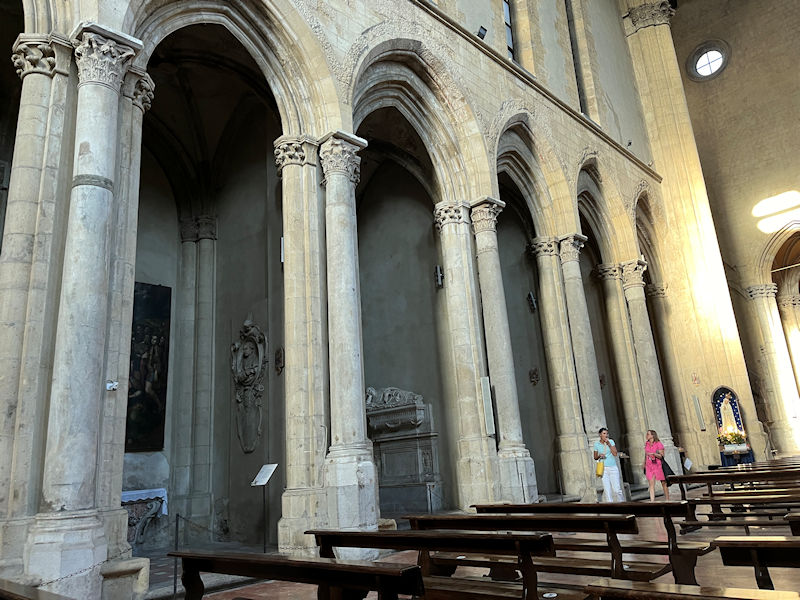
General views of the sides of the nave
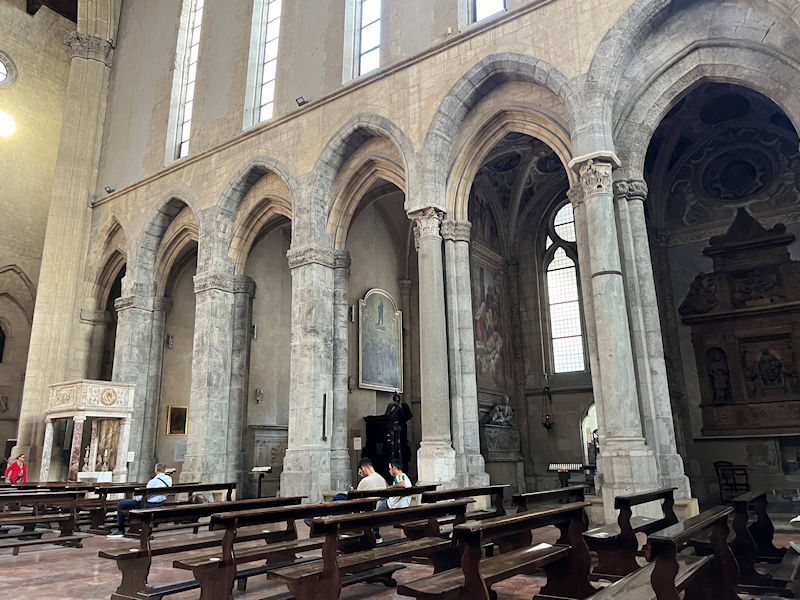
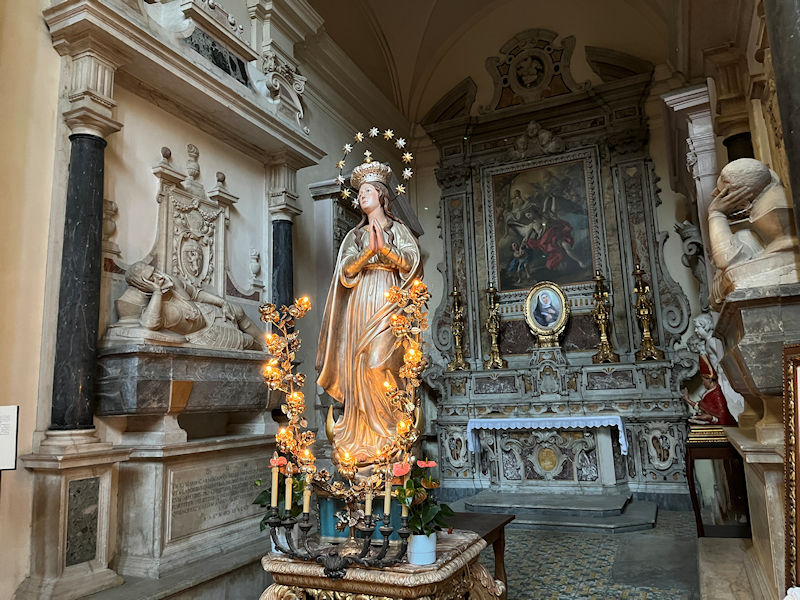
In the background is a painting of a Guardian Angel by Francesco De Mura (1696-1782).
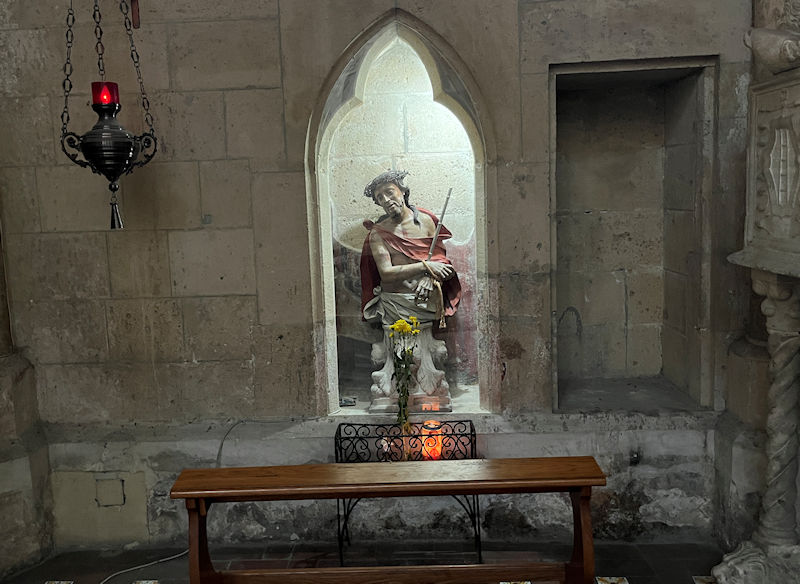
Jesus with a crown of thorns and bound hands and what appears to be a gentle smile of understanding.
A few more photos that we haven't been able to identify
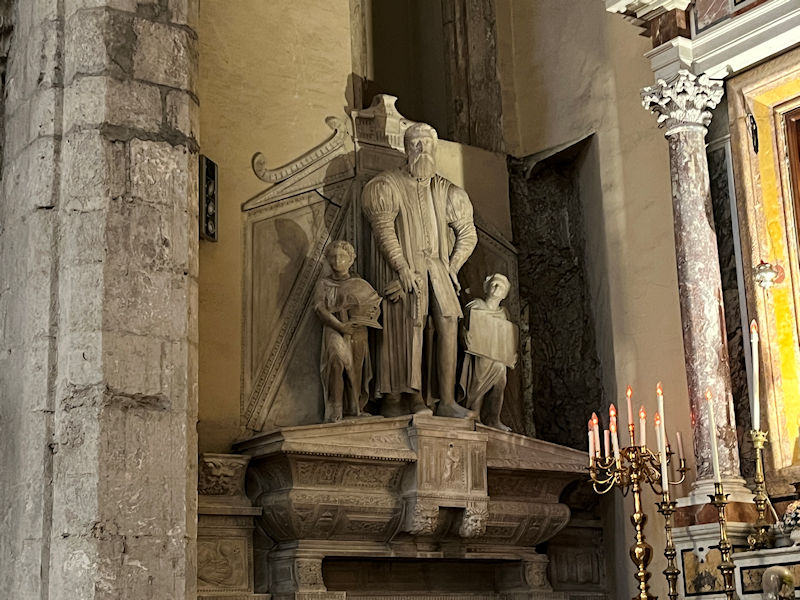
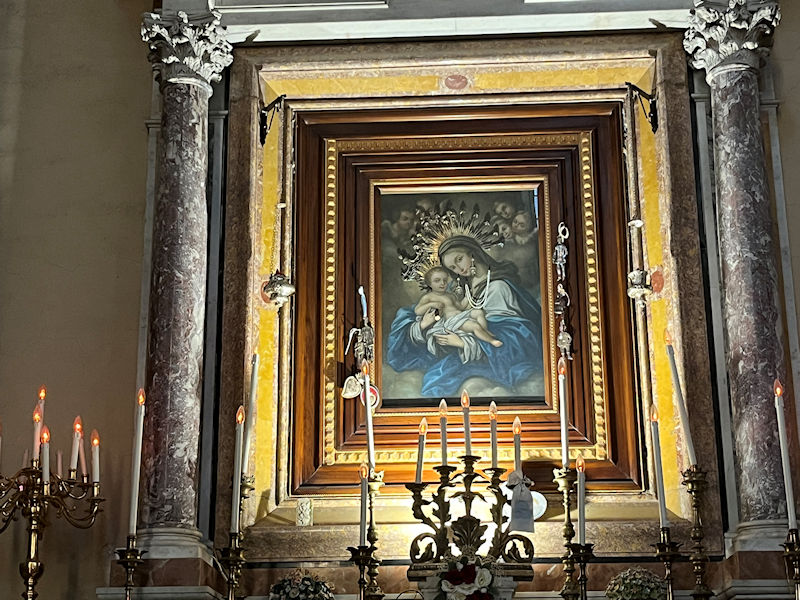
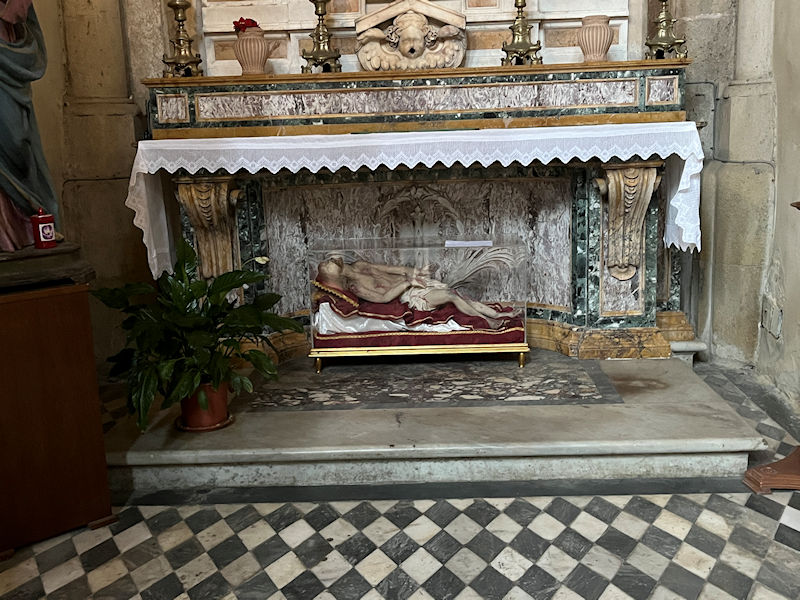
Oh, yuck!

The glass windows under the floor of the transept allow views of the very early mosaic flooring below, amongst the recent excavations.
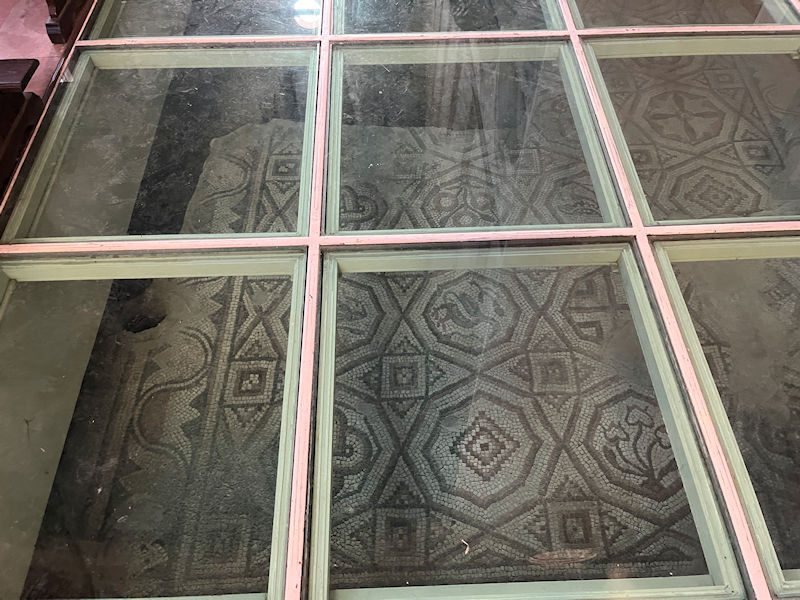
They were part of the sacristy of the early Christian basilica of the 6th century, where sacred vestments etc. were stored.
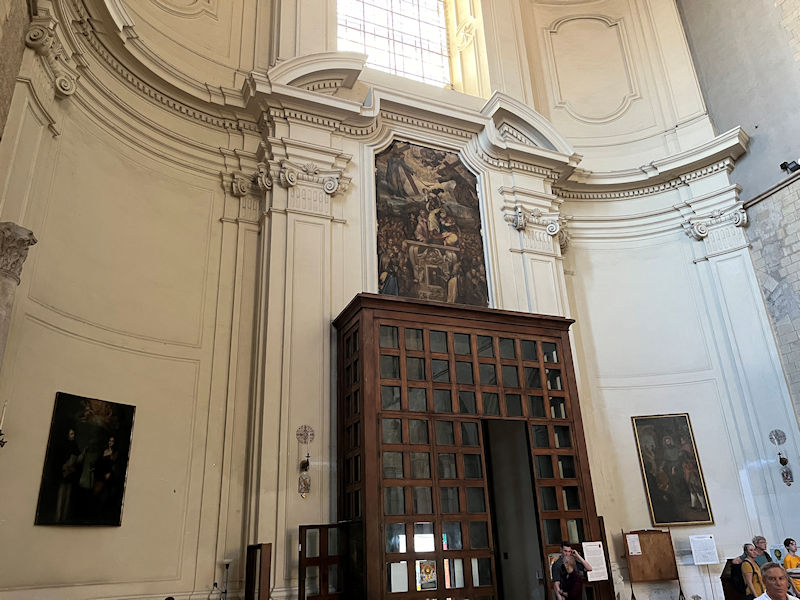
There's much more to be seen here -- there's more good stuff in the church, of course, but there are also the monastery (both belonging to the Conventual branch of the Franciscans), the cloister, a new museum covering the ancient and more recent history of the area, and the excavated Roman market below.
We should mention that it was probably in the Basilica di San Lorenzo that in 1336 Giovanni Boccaccio first met the ‘inspiring muse’ that he called Fiammetta in many of his works (Maria, the natural daughter of King Robert the Wise) – rather like Dante’s Beatrice and Petrarch’s Laura.
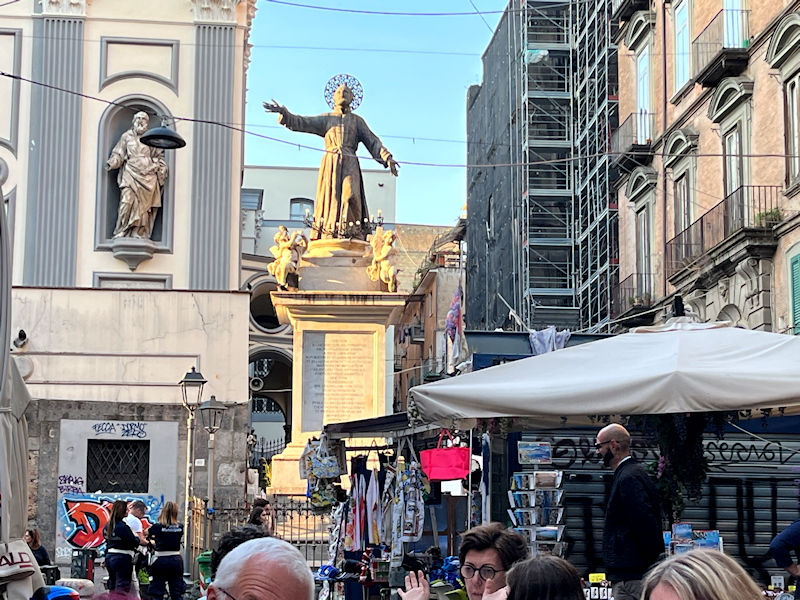
Right outside San Lorenzo, that's the Monument to San Gaetano in front of the Basilica di San Paolo Maggiore. Now we're off for home; it's mostly downhill. Dinner at Ciro again, all good.
Next up: The Monastery and Museum of San Martino up the hill
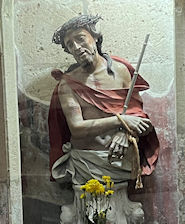 Dwight Peck's personal website
Dwight Peck's personal website







































































